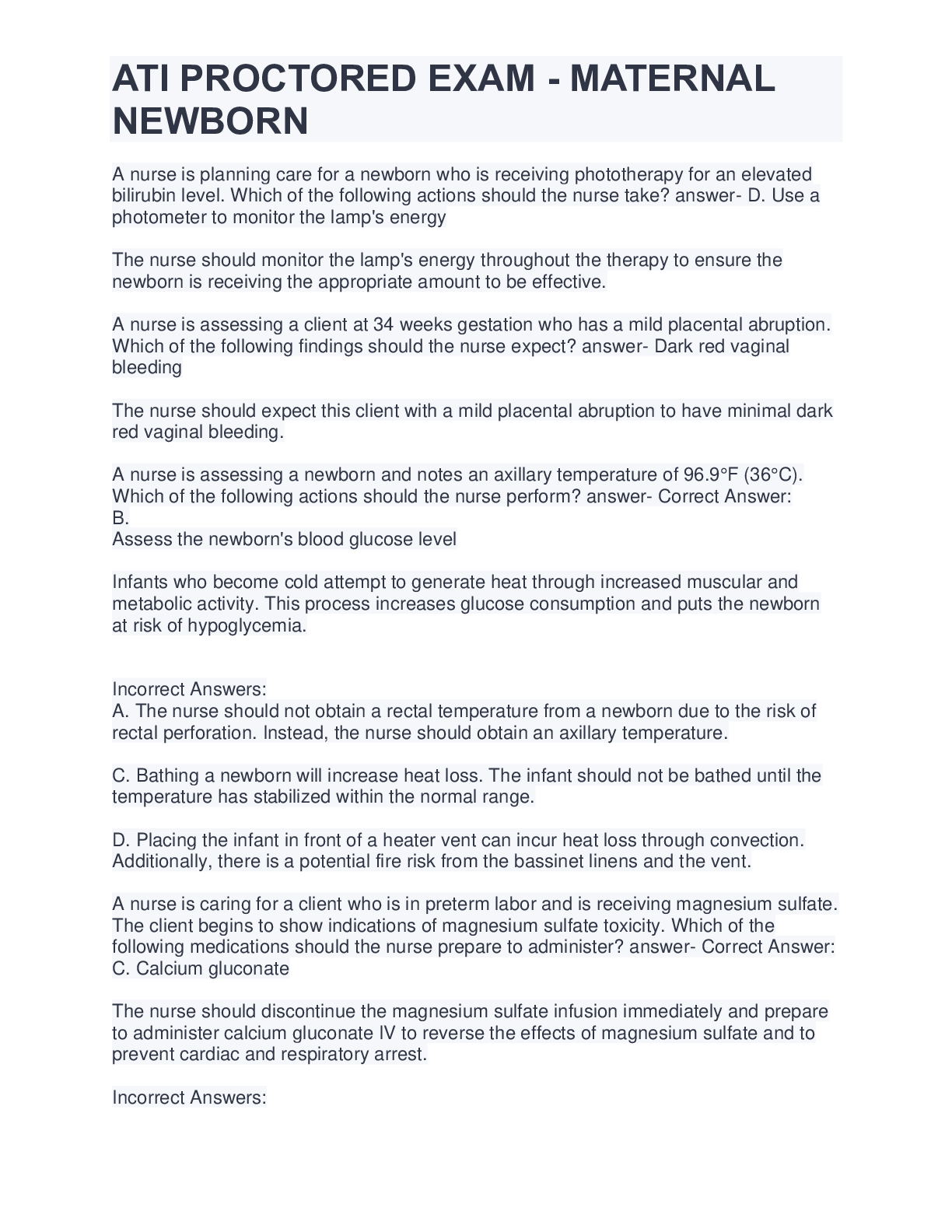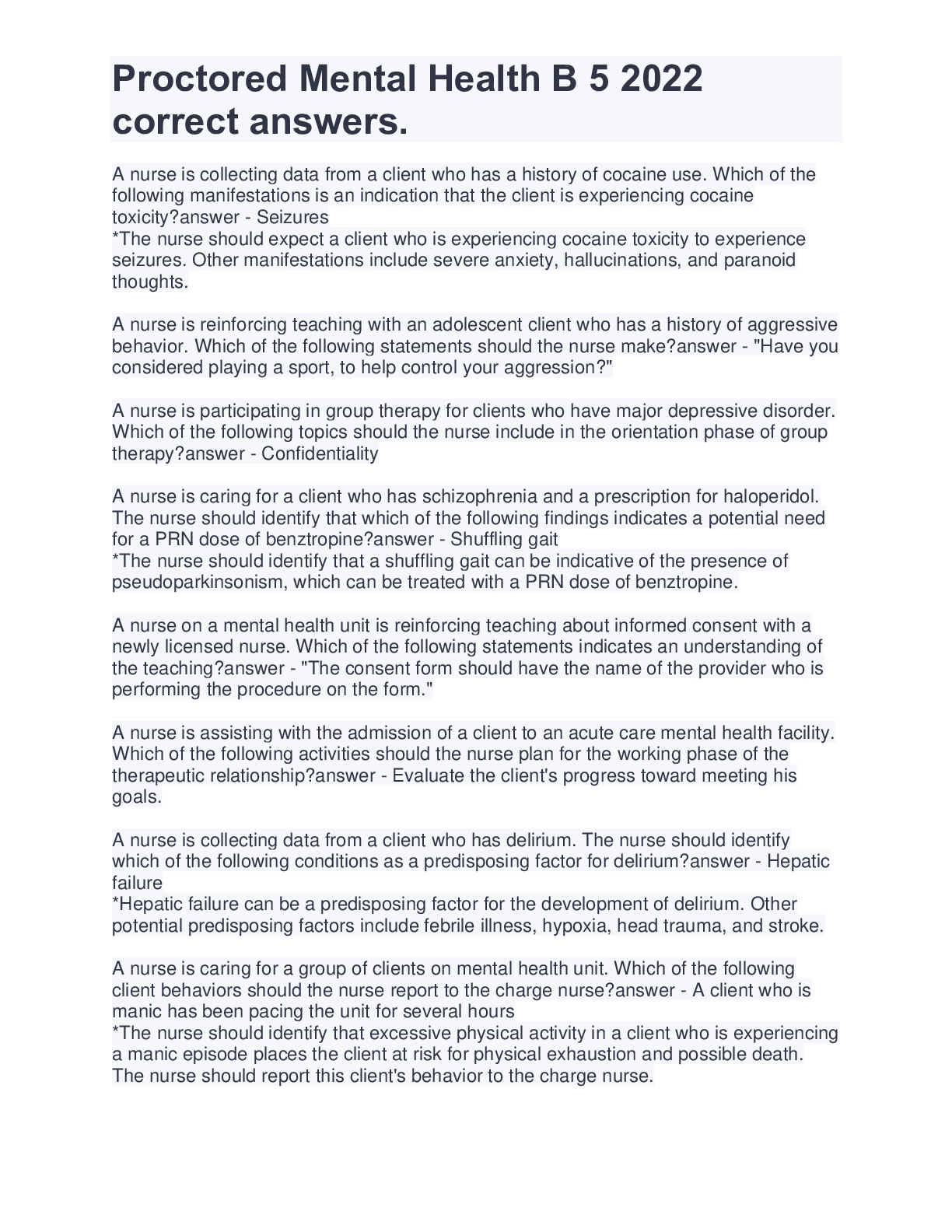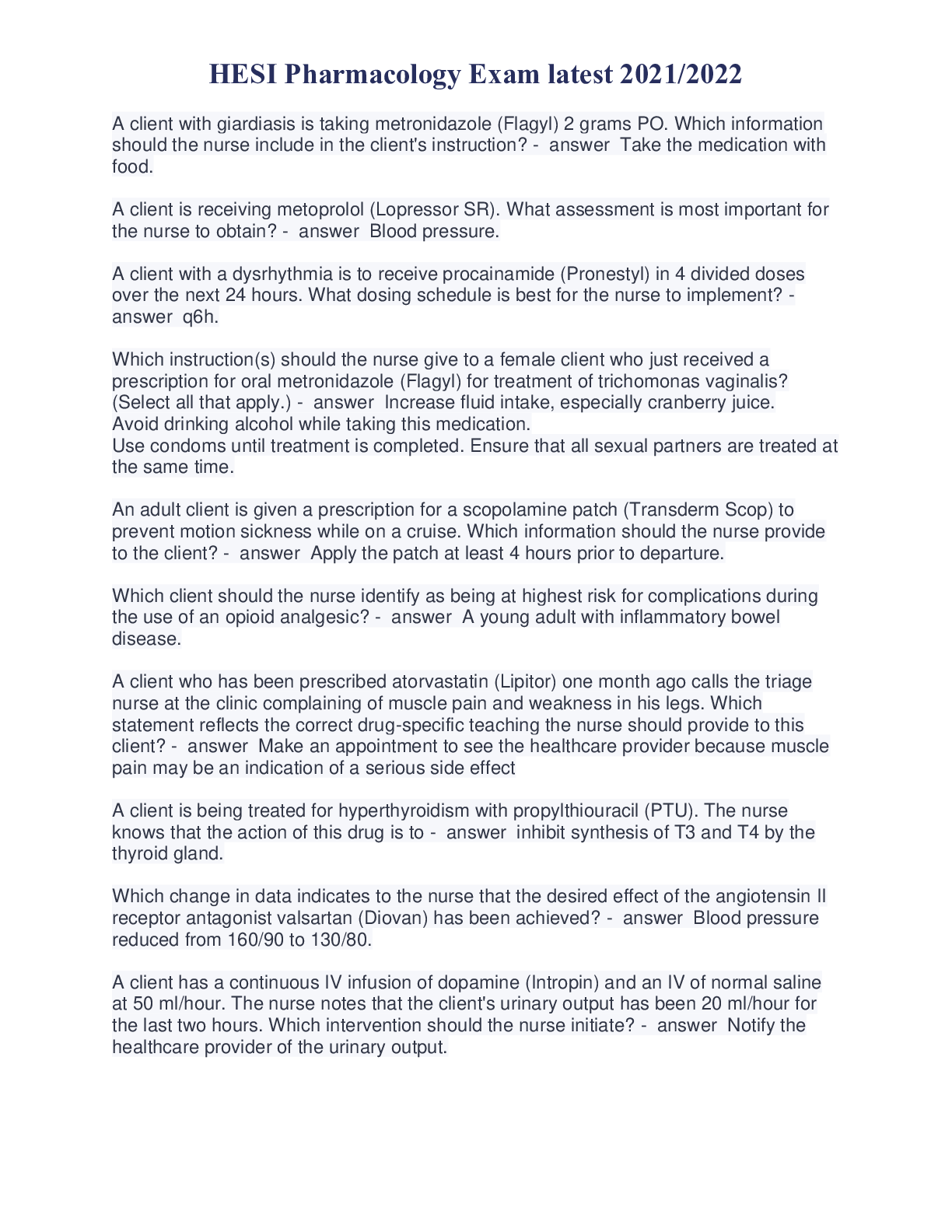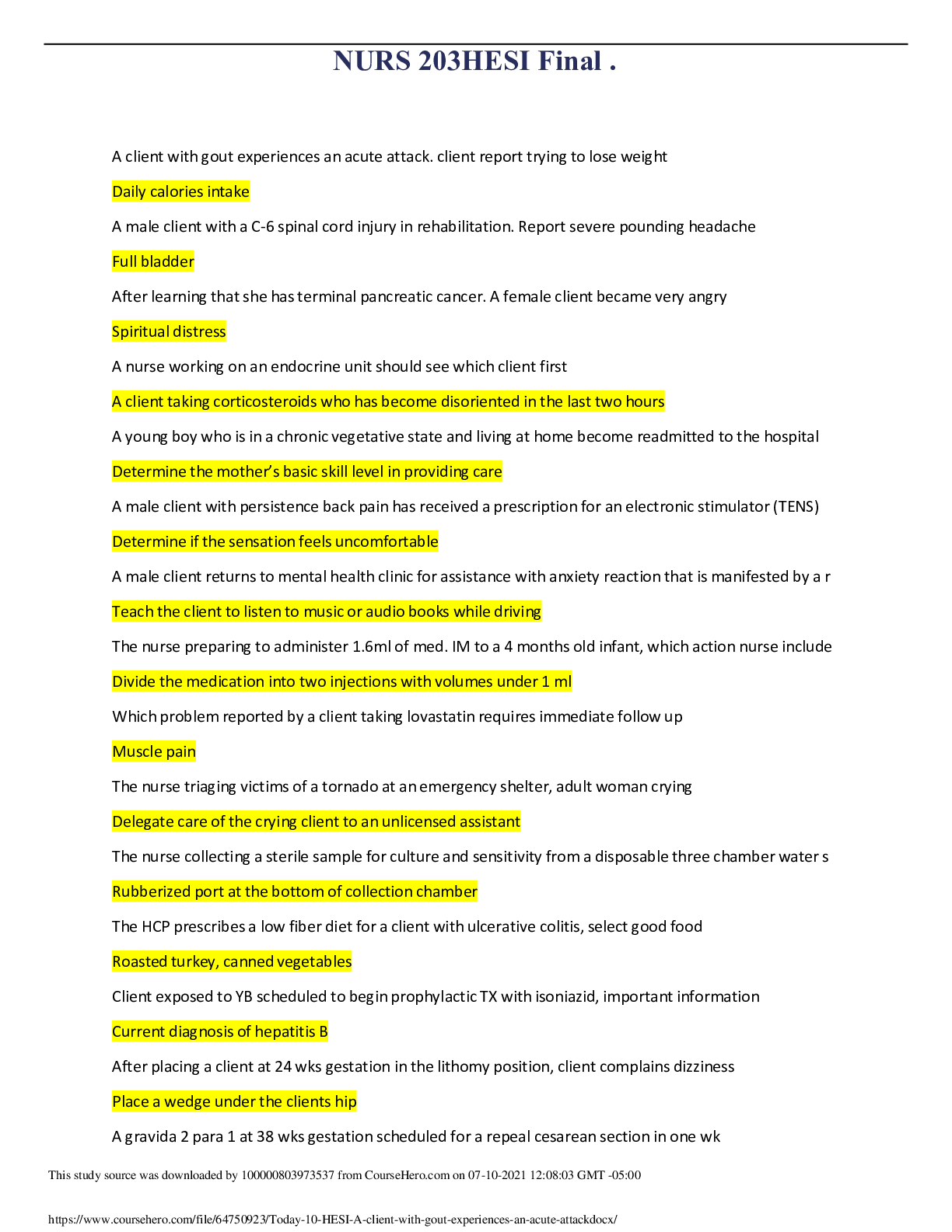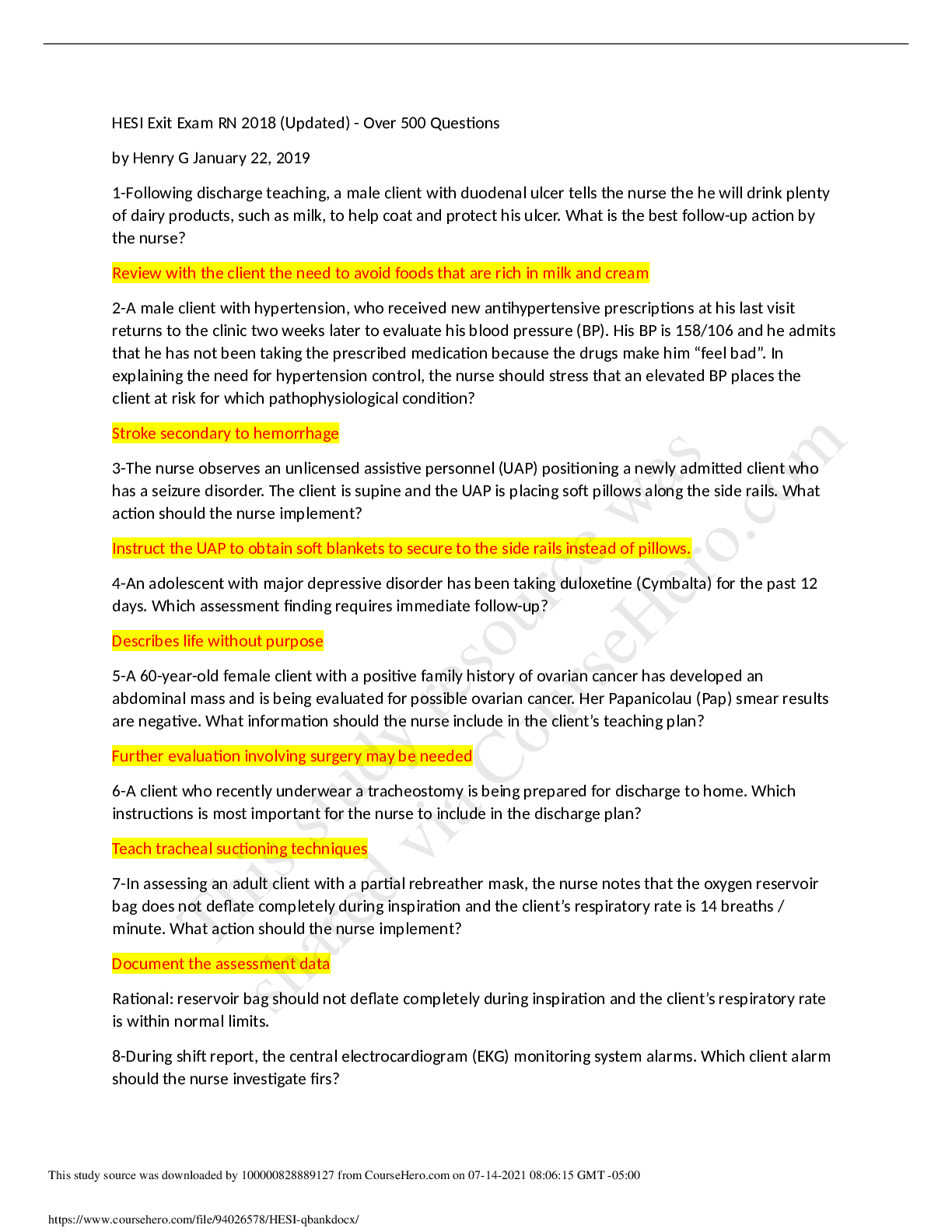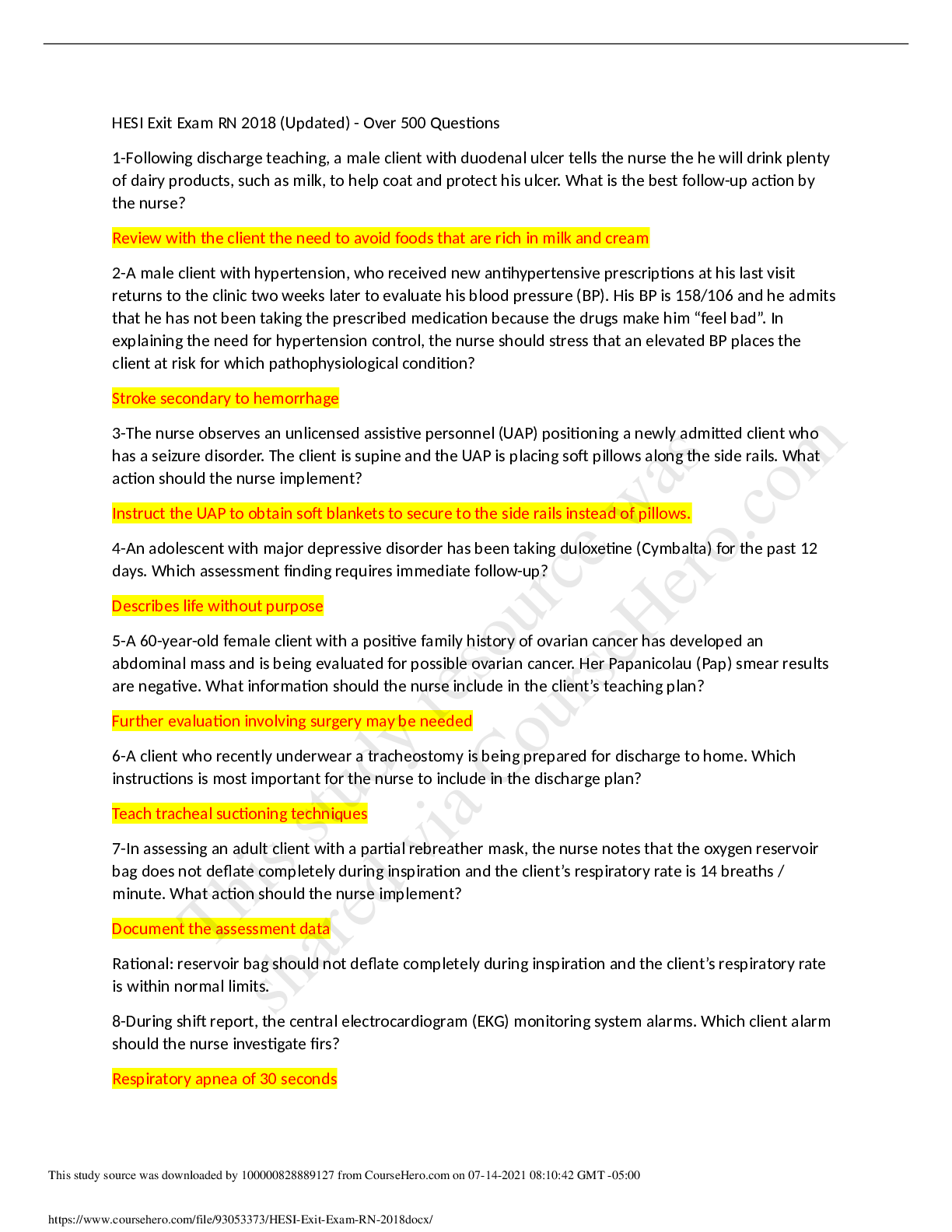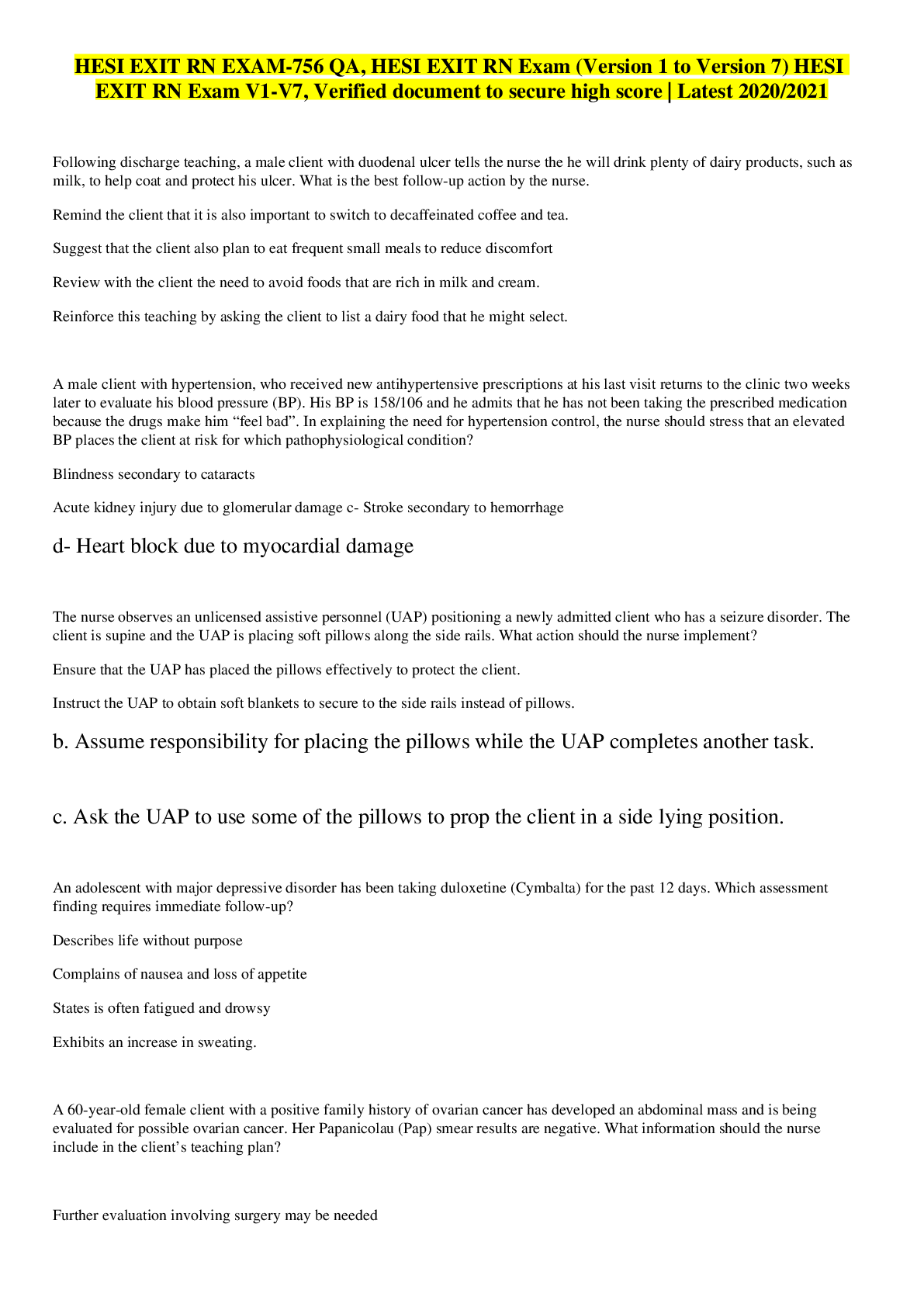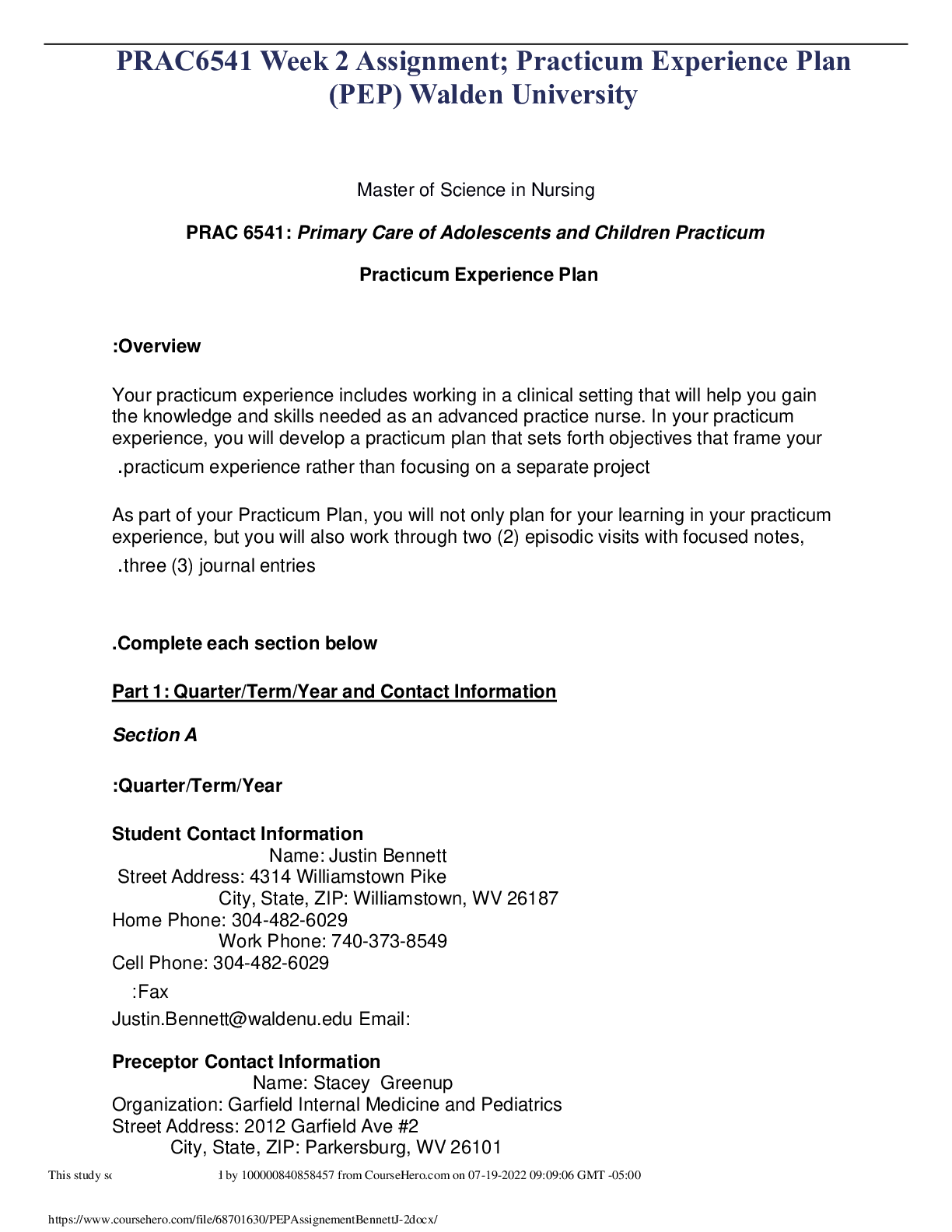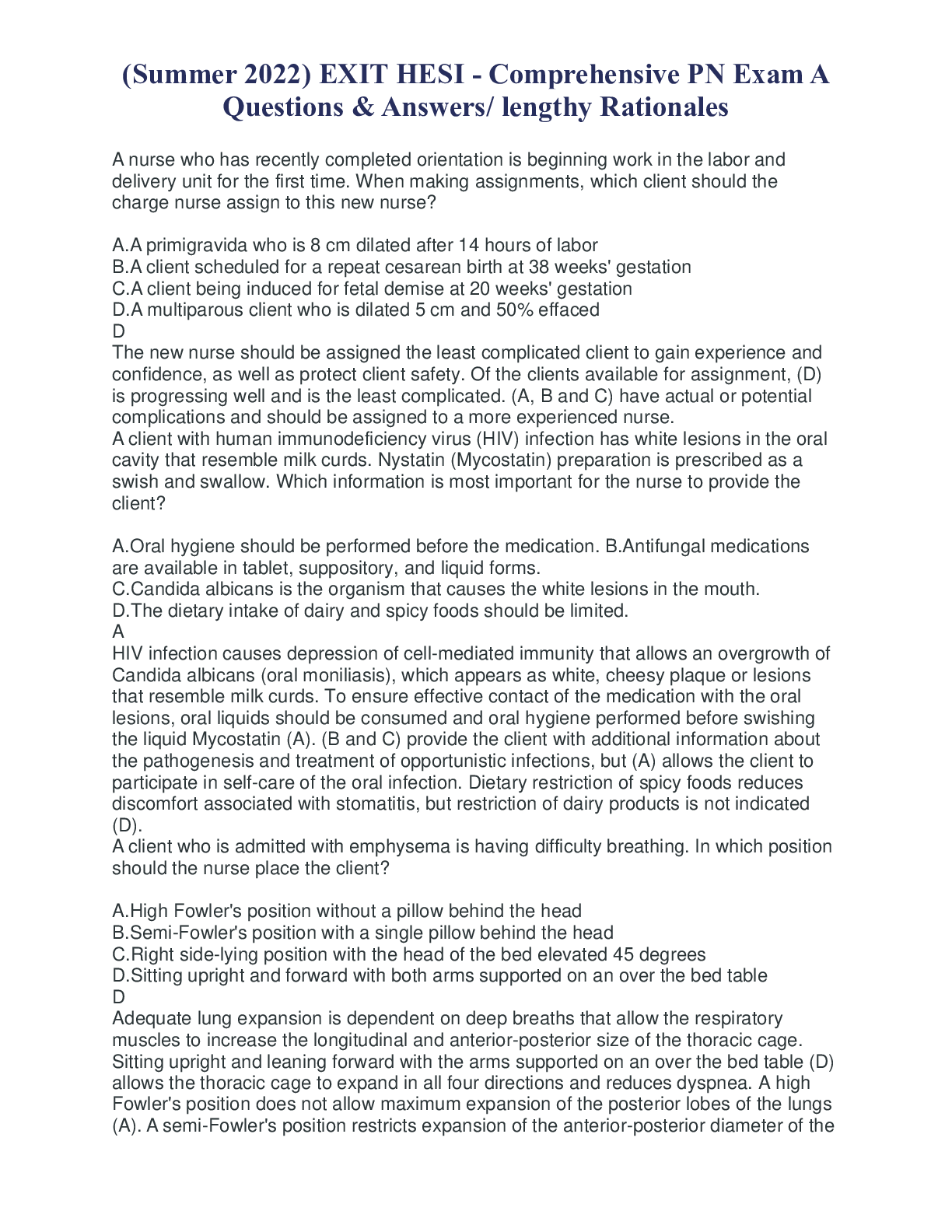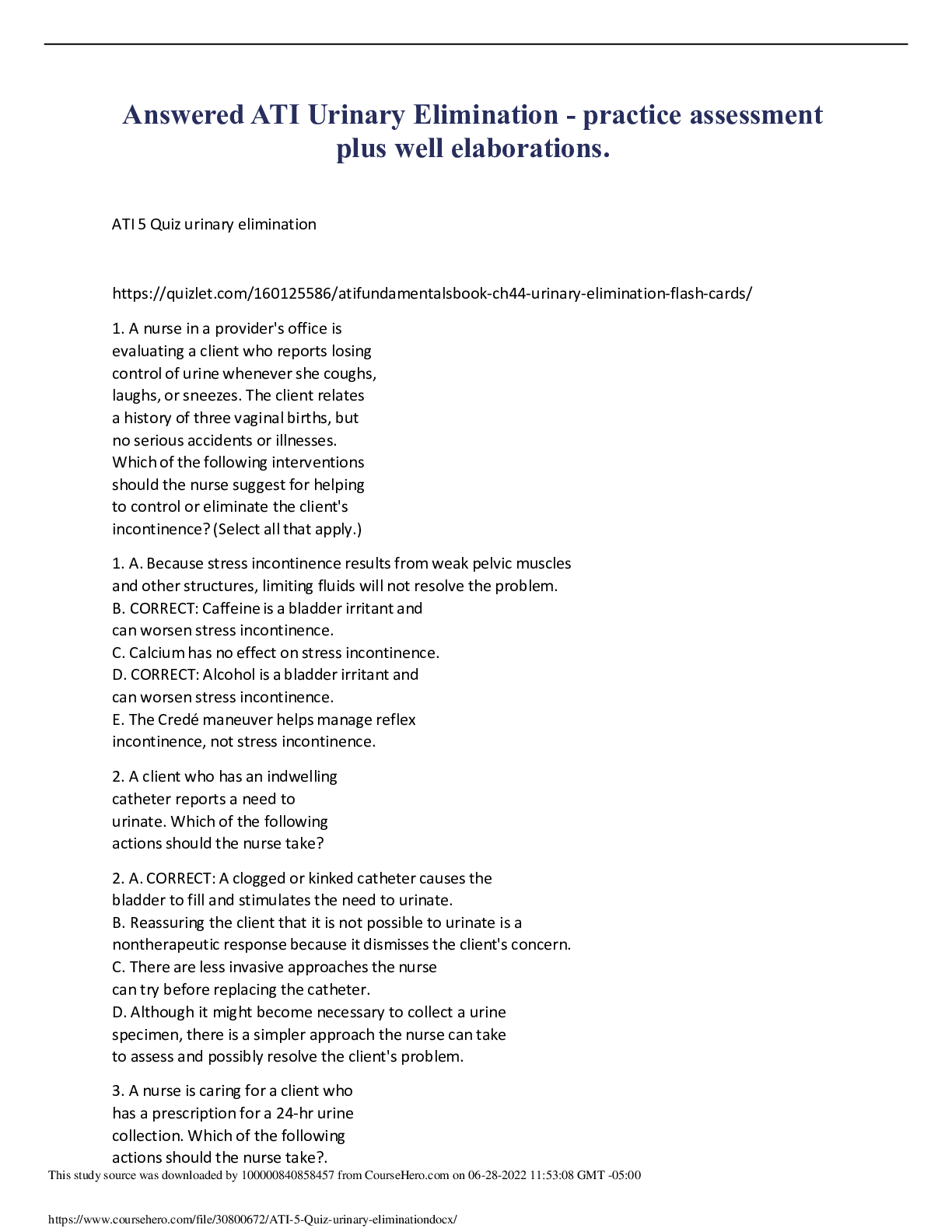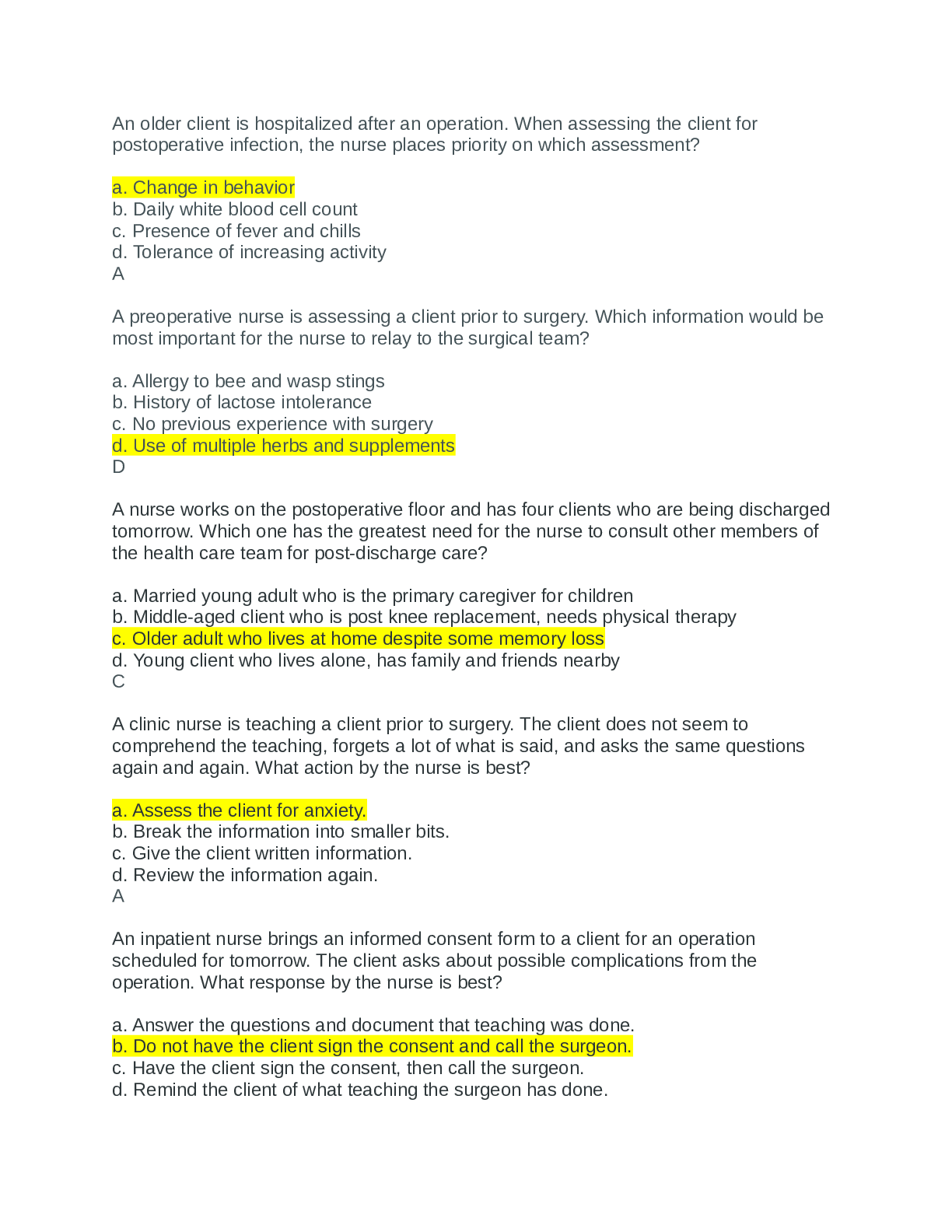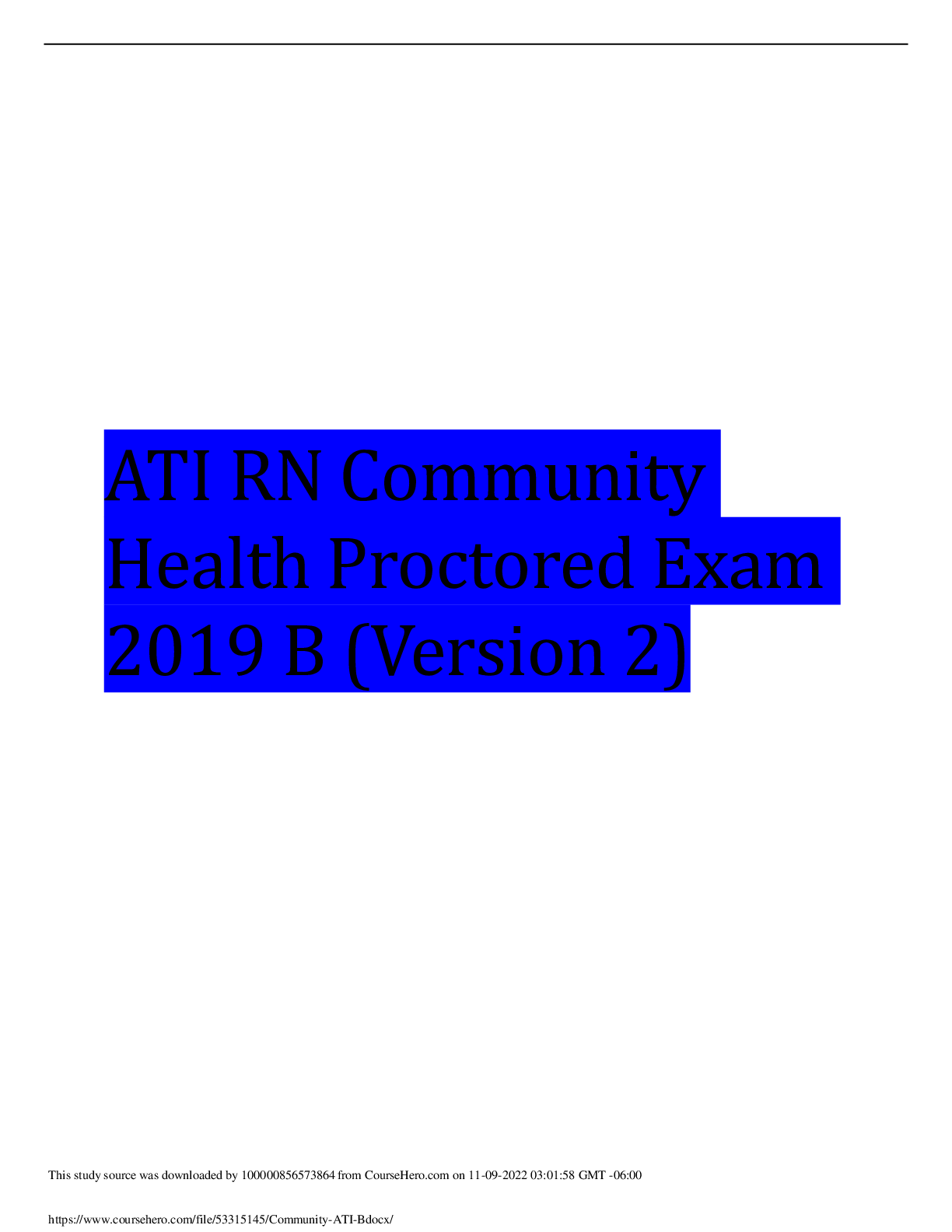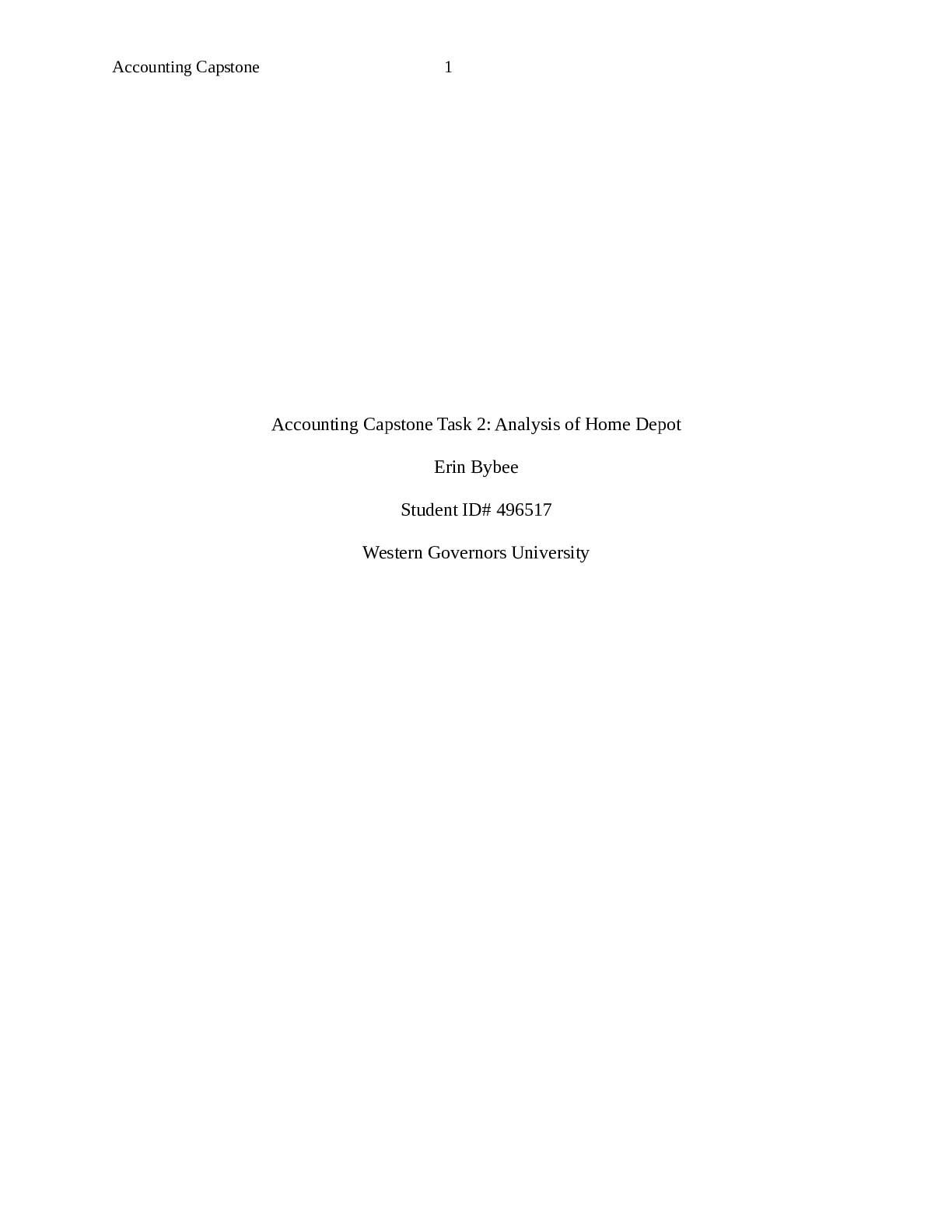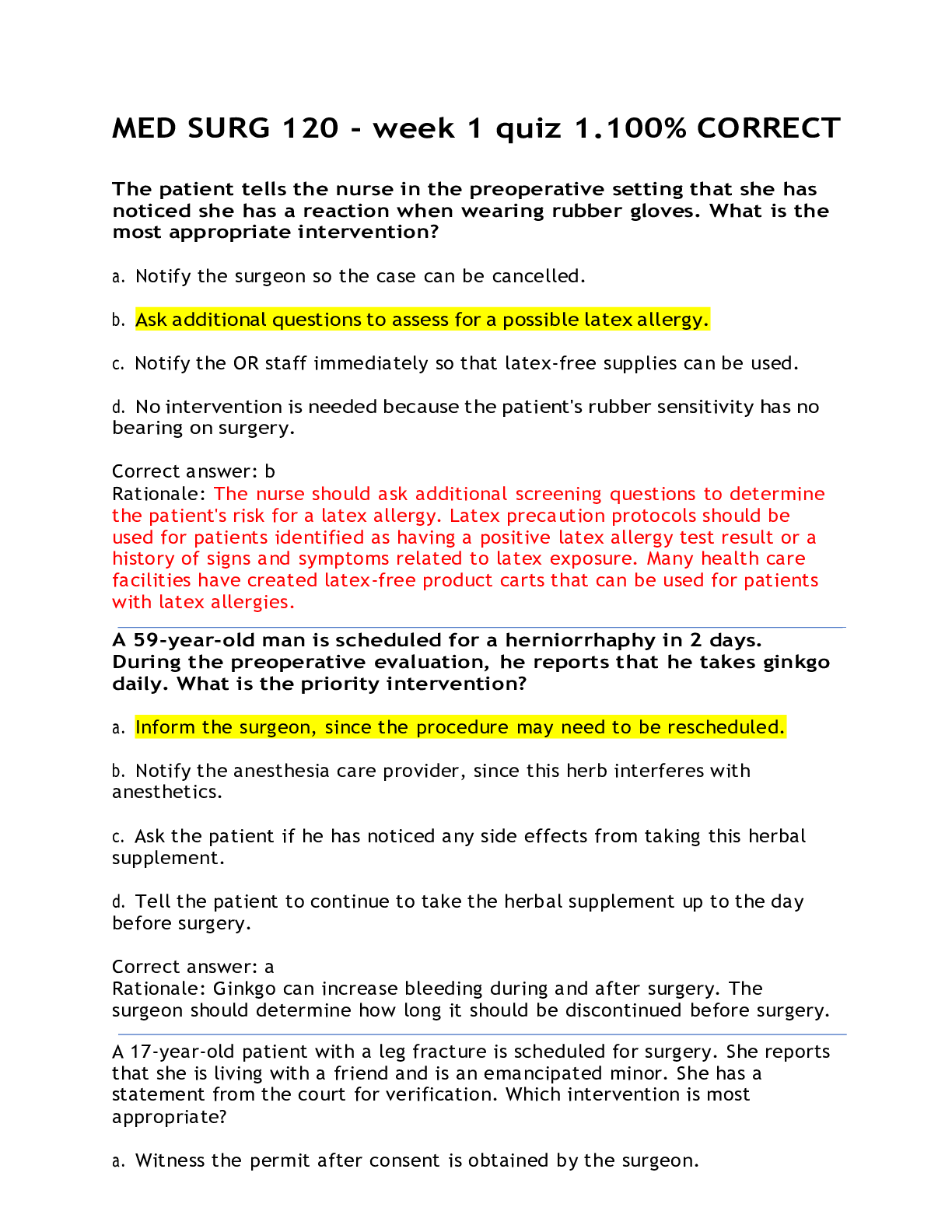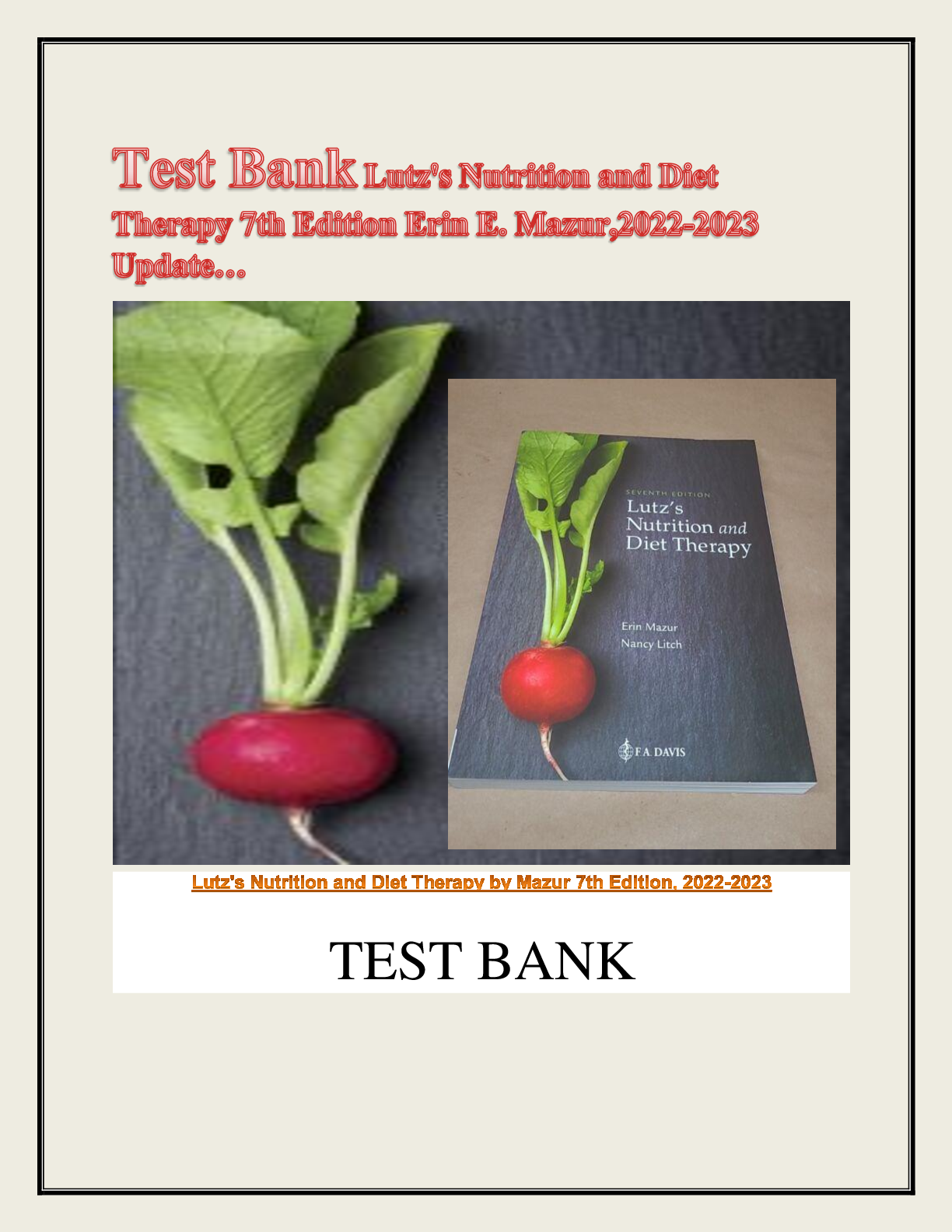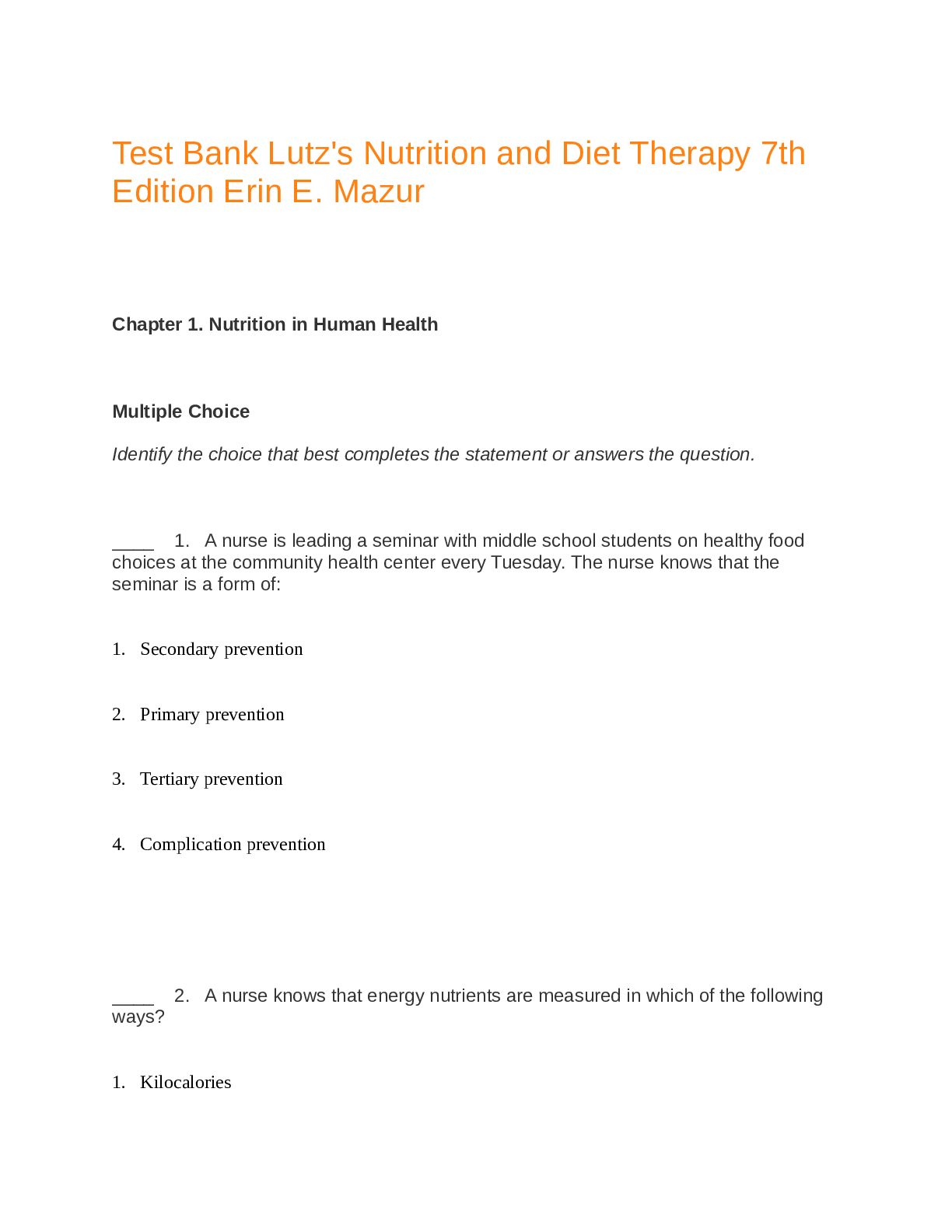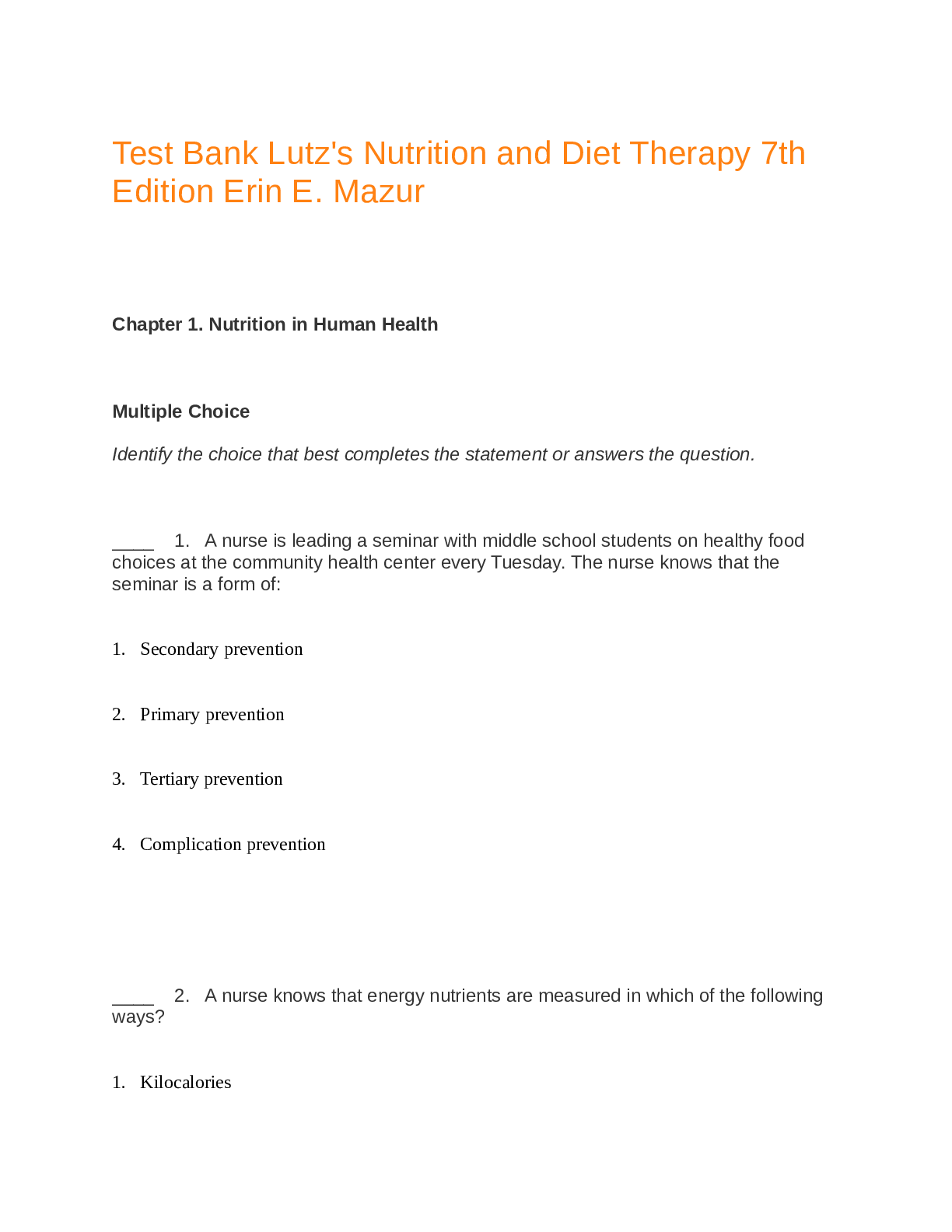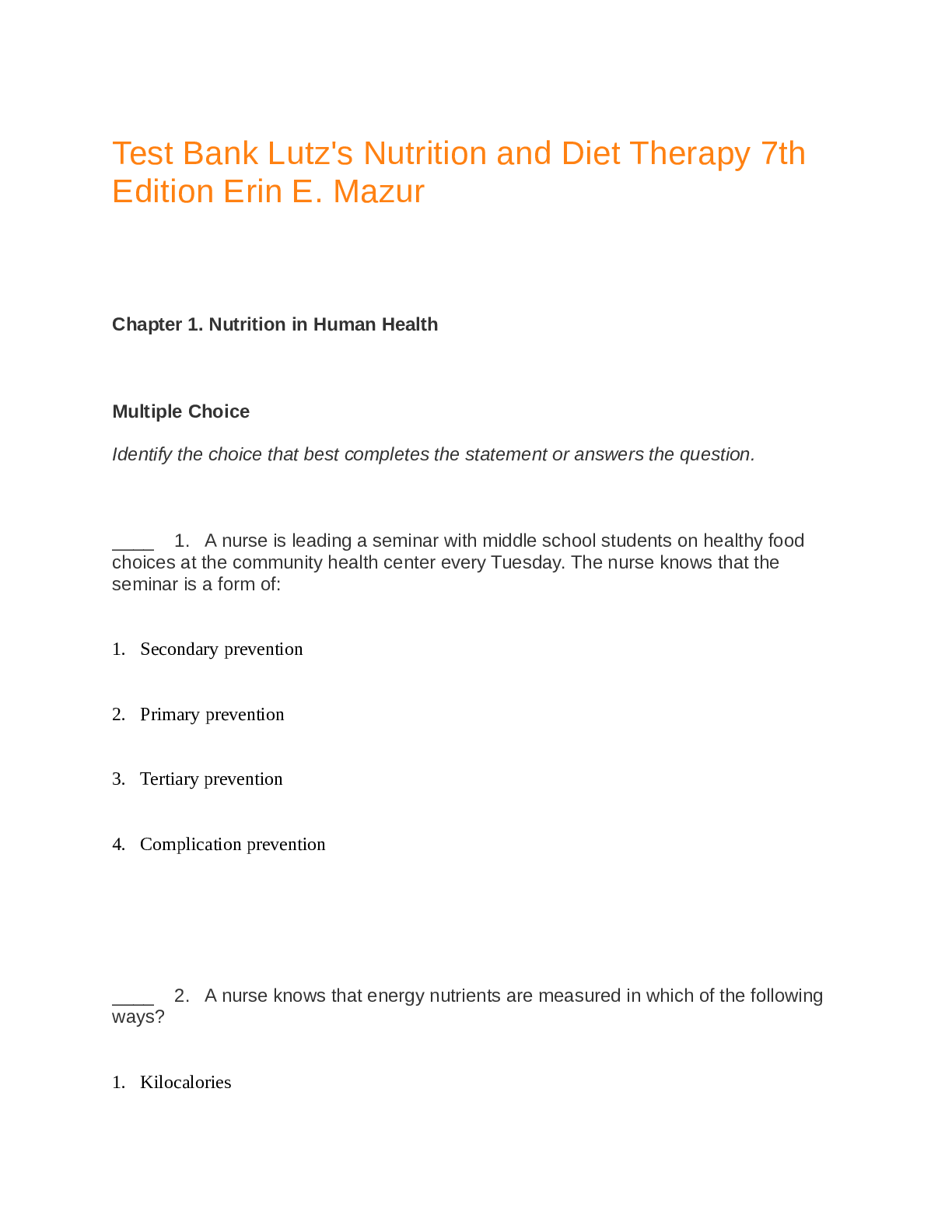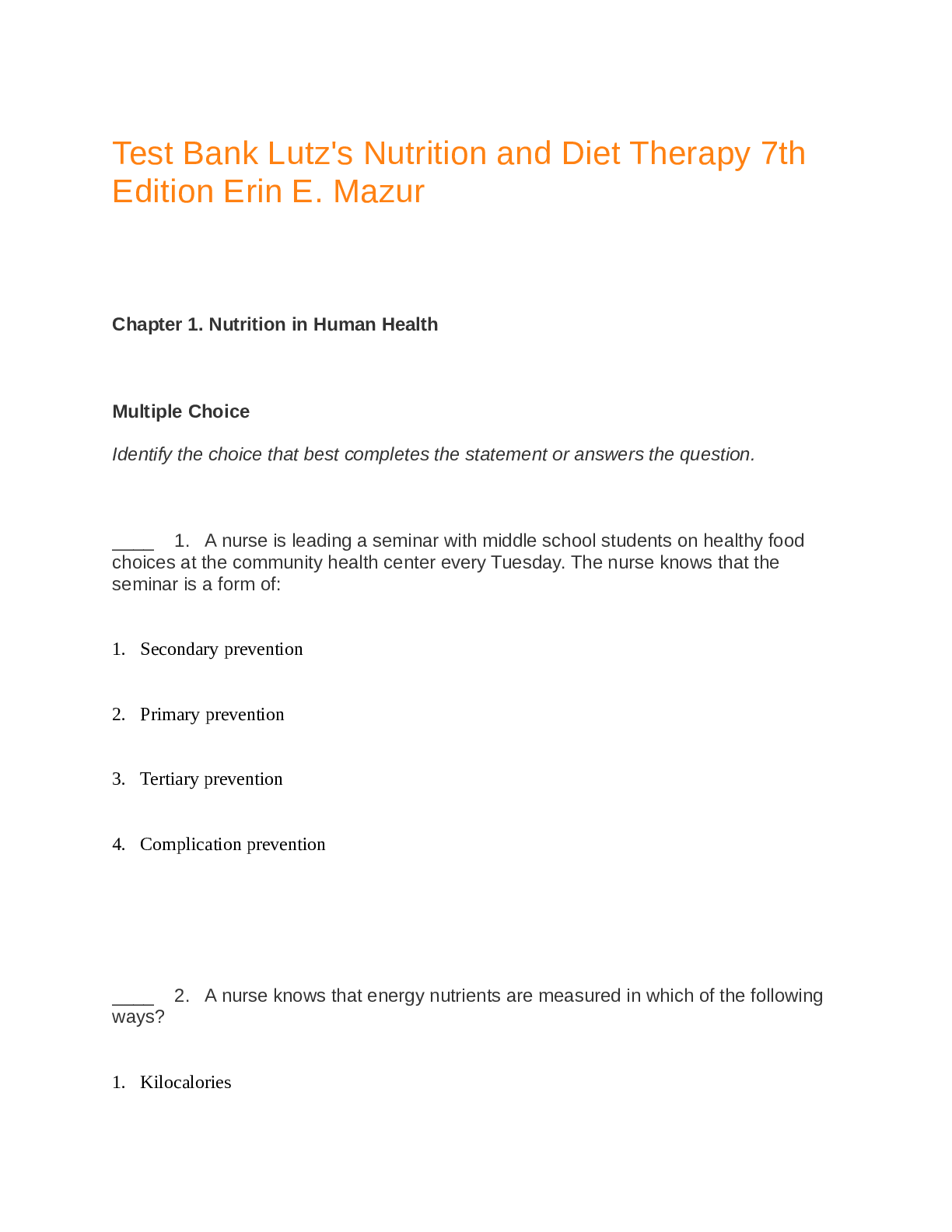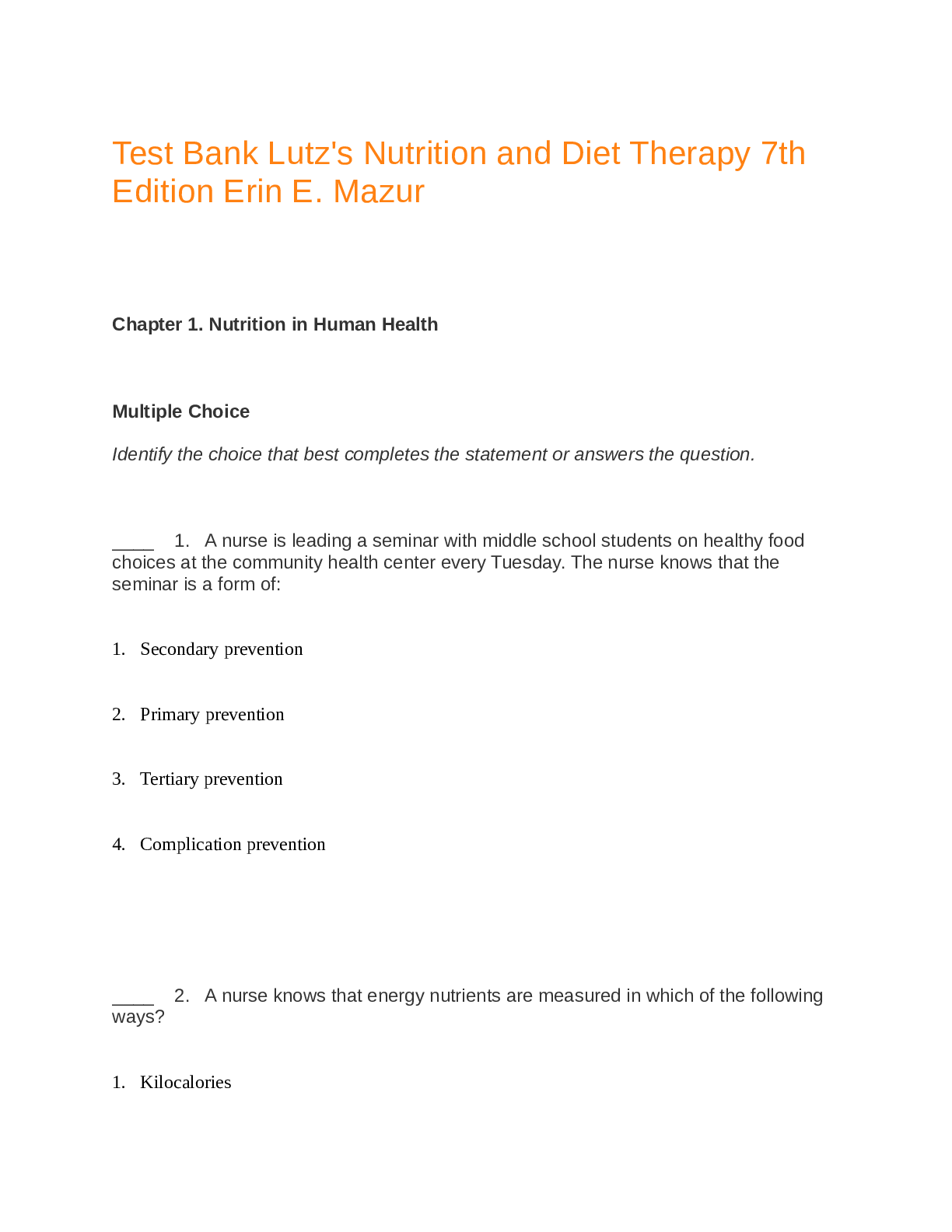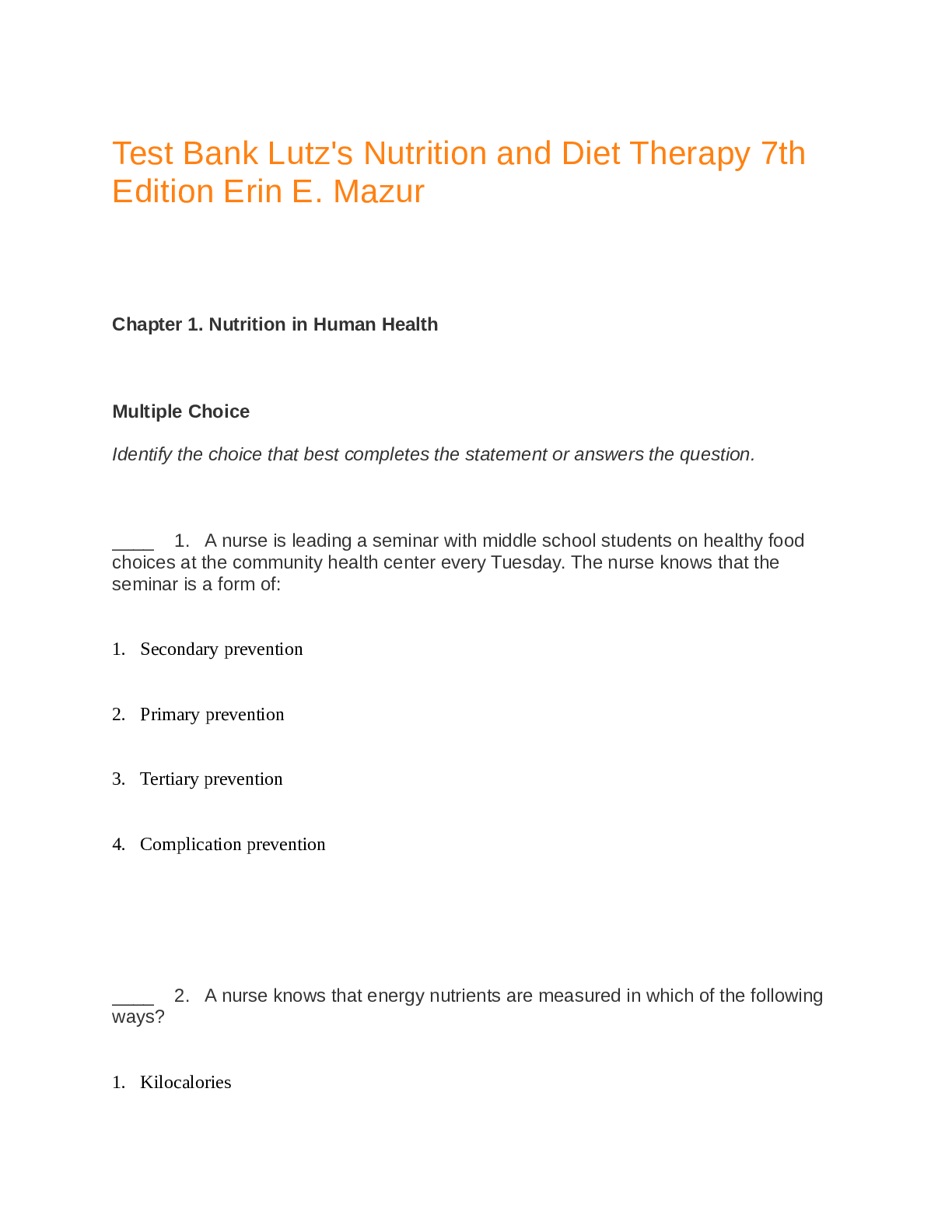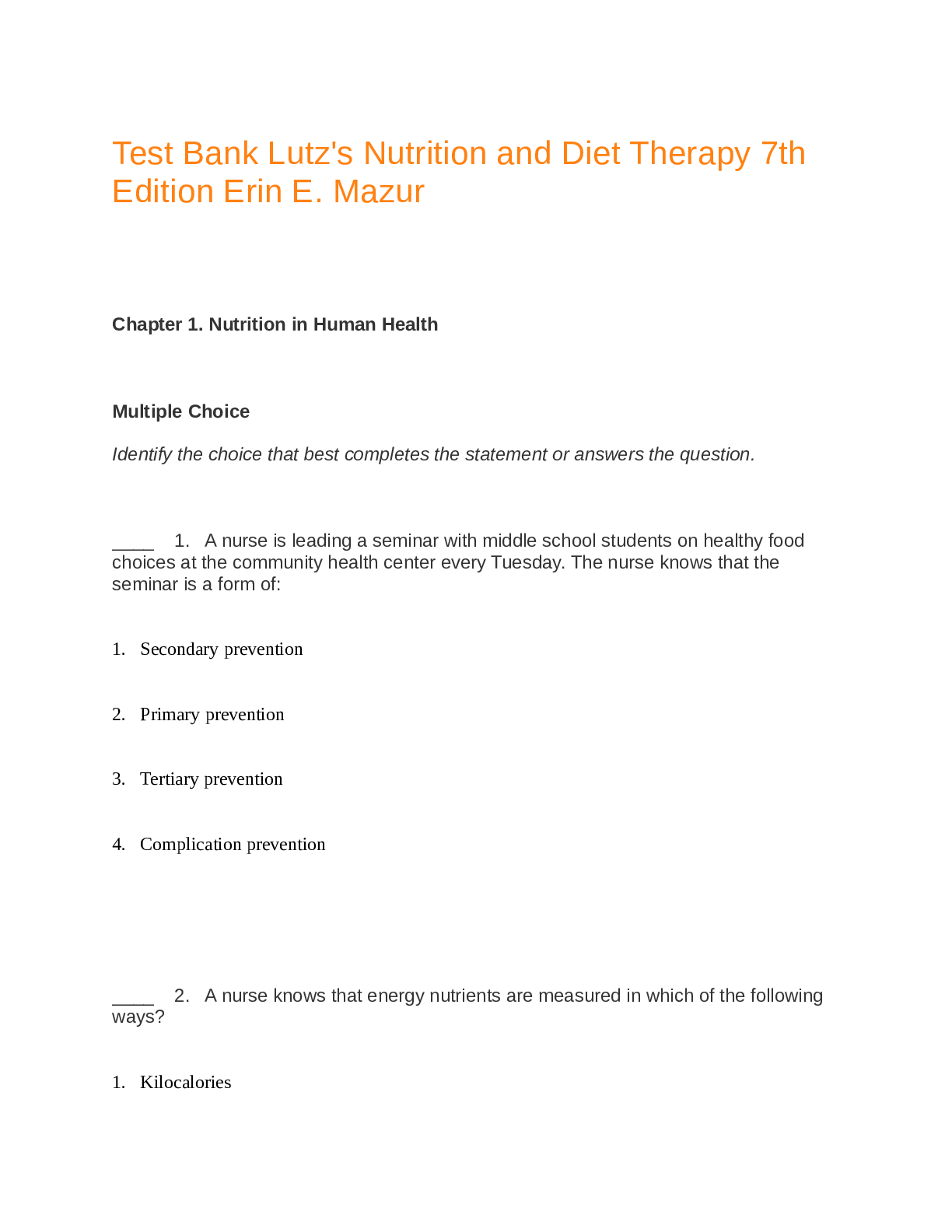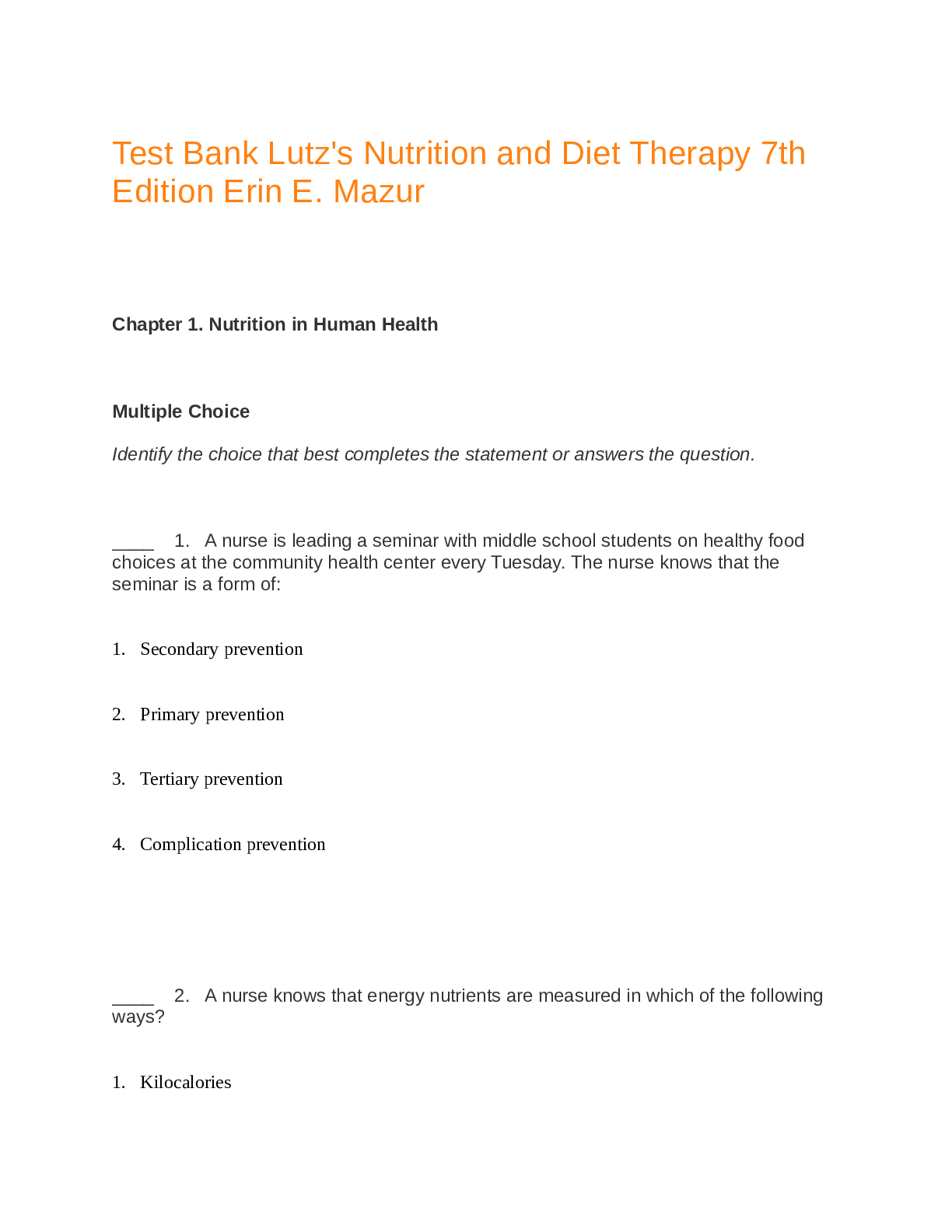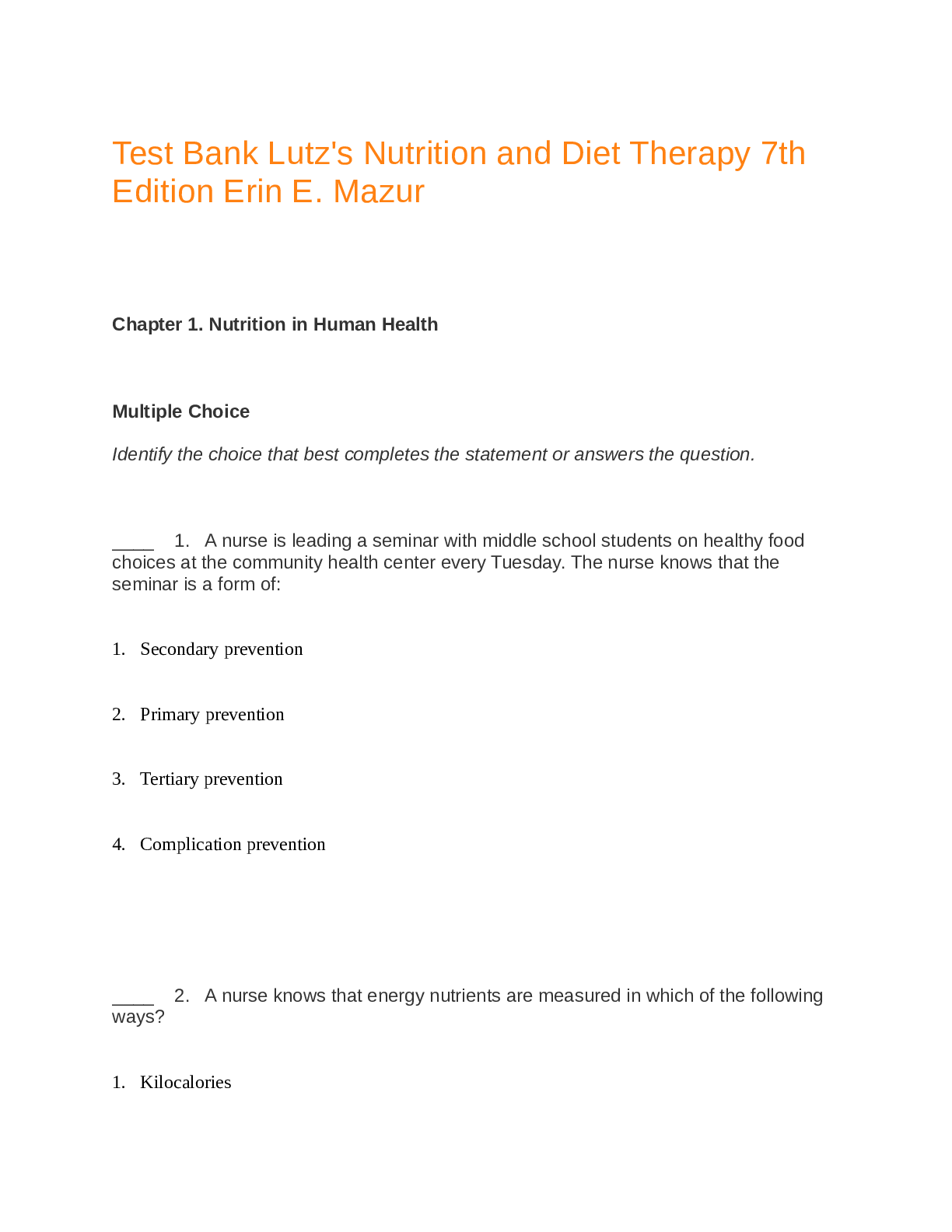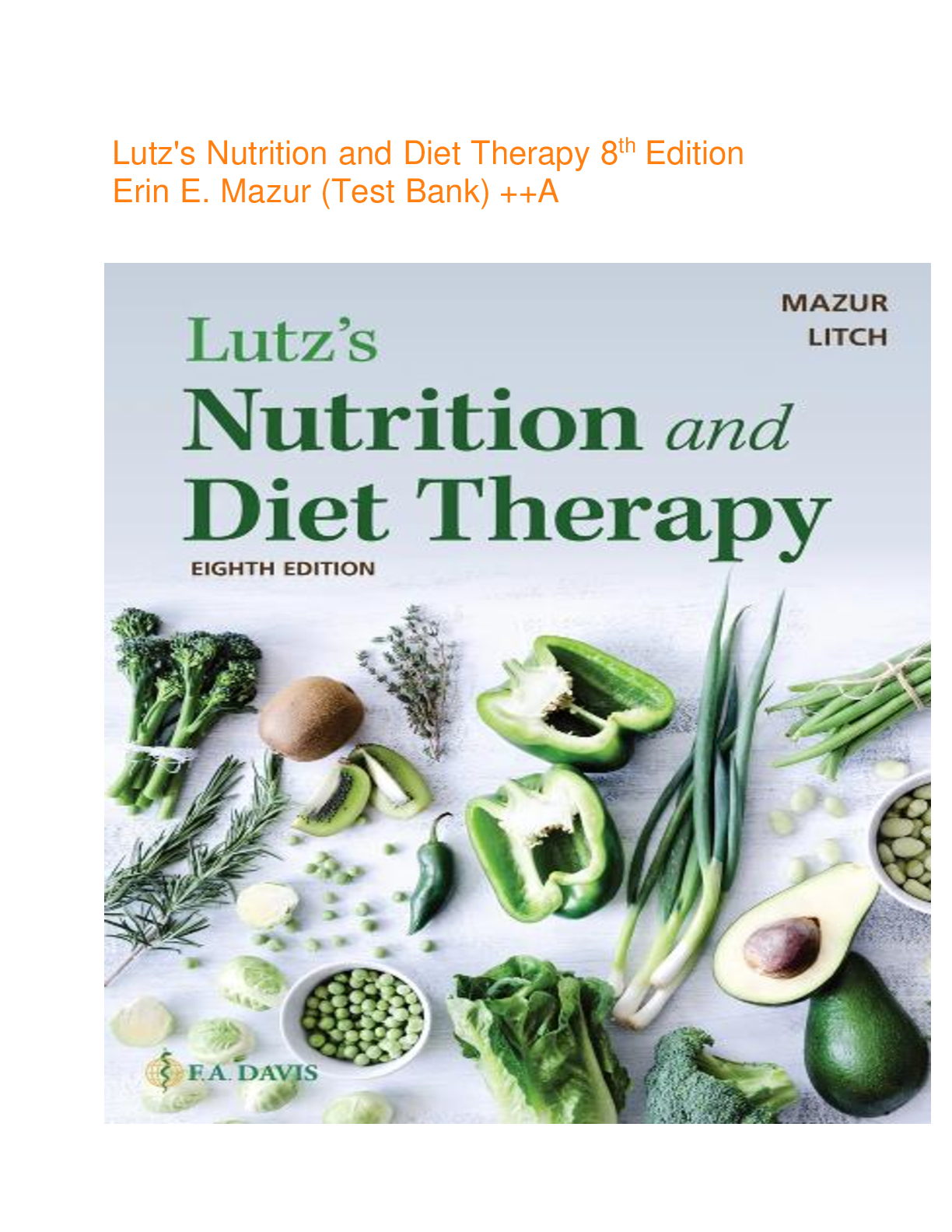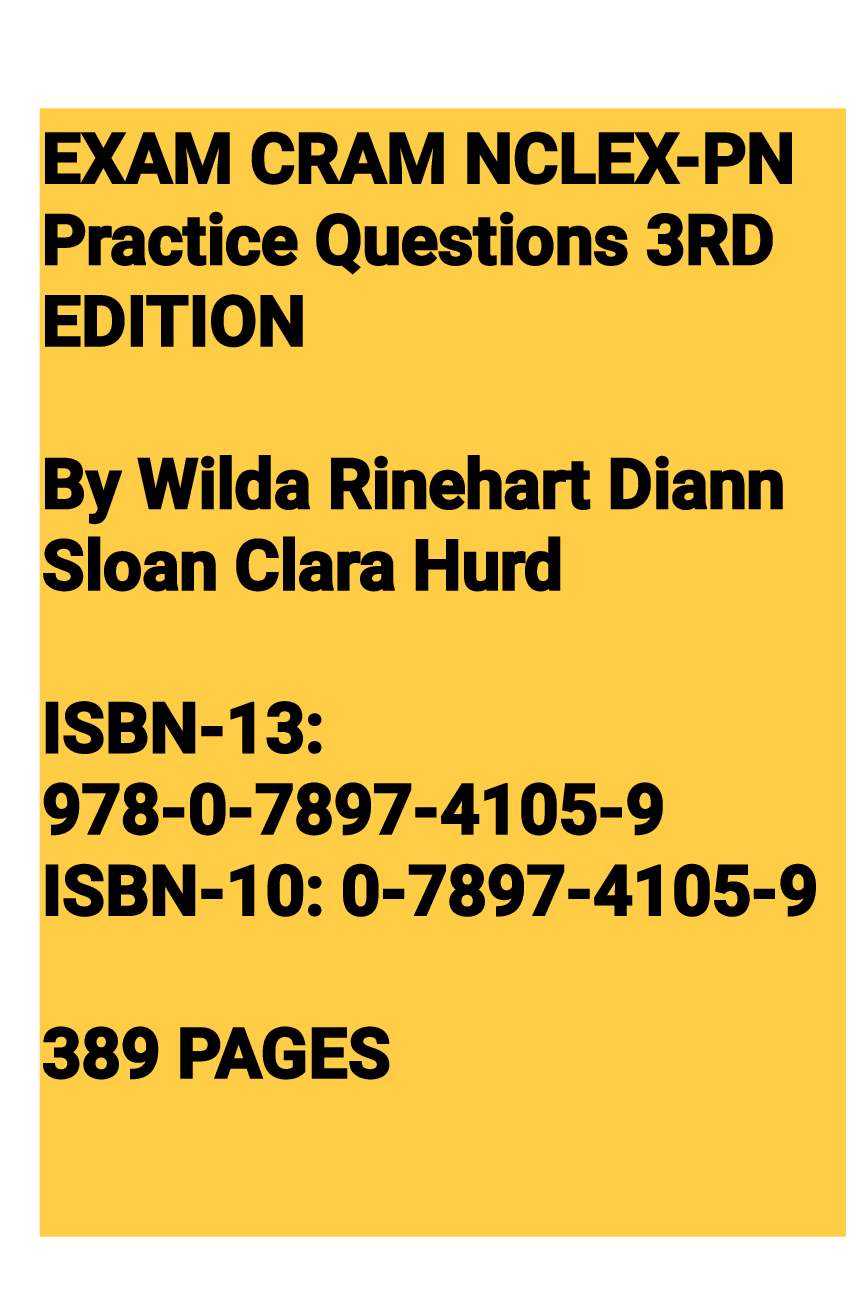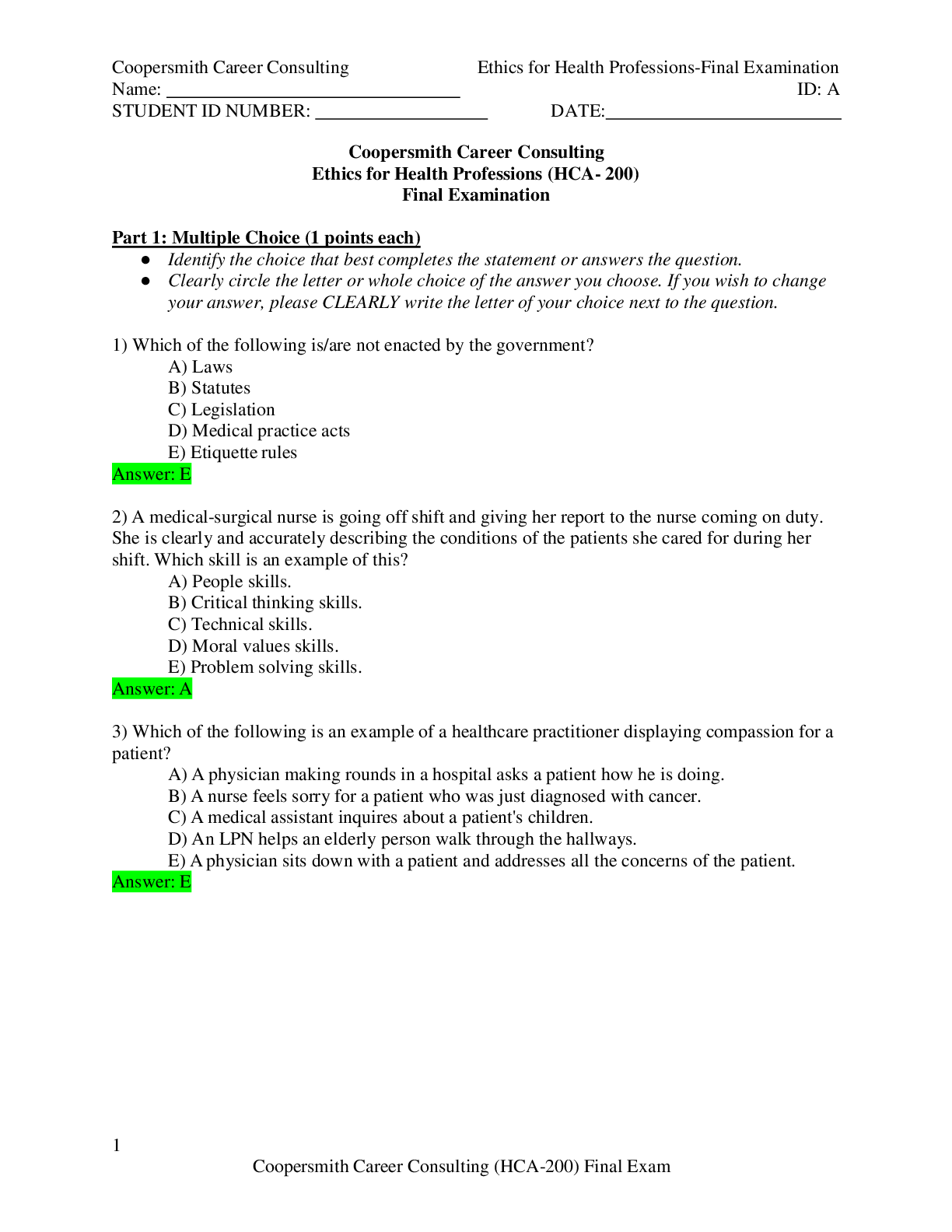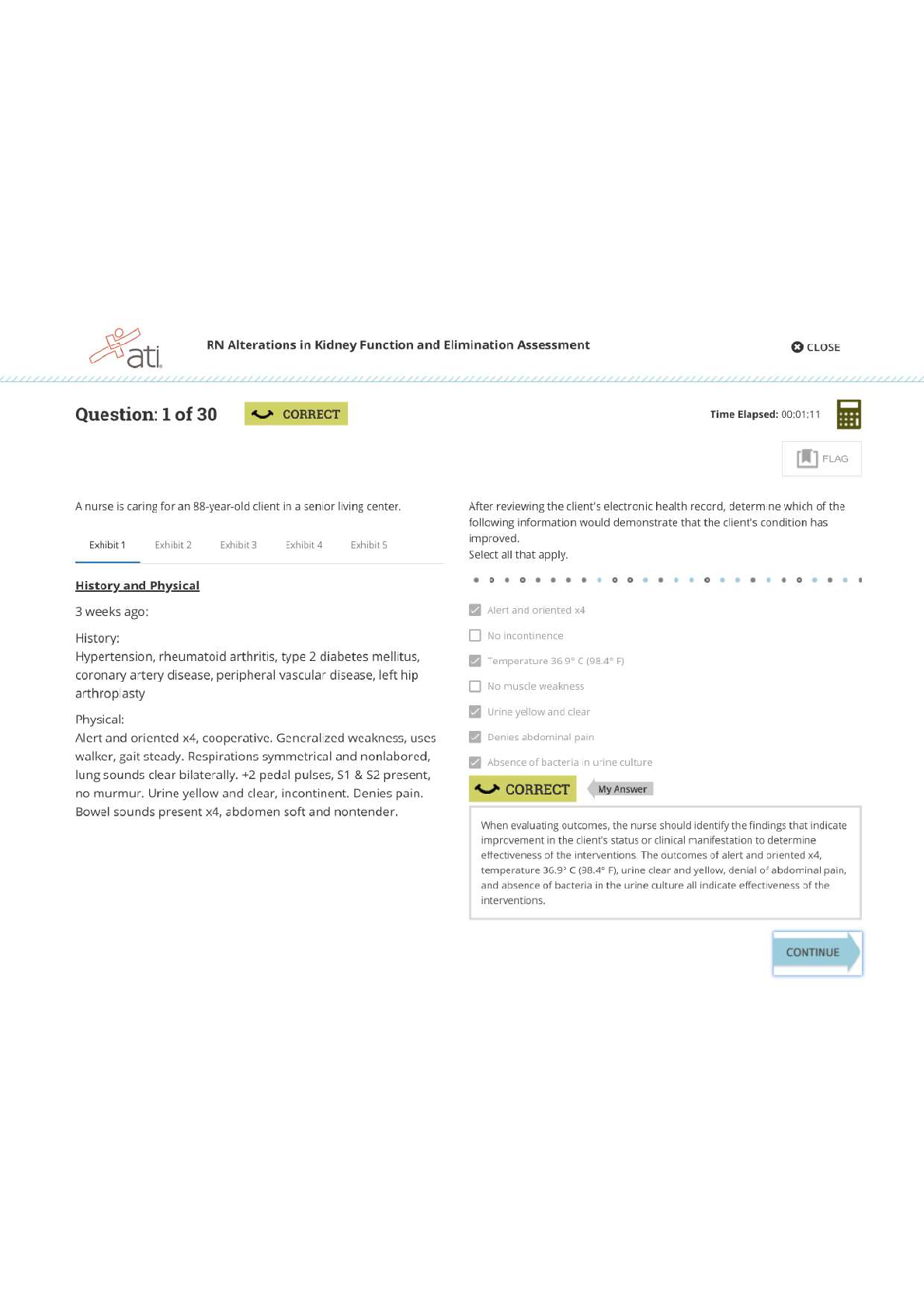*NURSING > EXAM > Test Bank Lutz's Nutrition and Diet Therapy 7th Edition Erin E. Mazur,WELL EXPLAINED . (All)
Test Bank Lutz's Nutrition and Diet Therapy 7th Edition Erin E. Mazur,WELL EXPLAINED .
Document Content and Description Below
1. A nurse is leading a seminar with middle school students on healthy food choices at the community health center every Tuesday. The nurse knows that the seminar is a form of: 1. Secondary preve... ntion 2. Primary prevention 3. Tertiary prevention 4. Complication prevention 2. A nurse knows that energy nutrients are measured in which of the following ways? 1. Kilocalories 2. Proteins 3. Heat (thermal) 4. Electric signals 3. A nurse is caring for a client with Crohn disease. The nurse notes that the health-care provider has ordered the addition of omega-3 fatty acids to the diet and omega-3 fatty acid supplement to the medication regimen. The nurse suspects the health-care provider is applying which process to help this client minimize chronic inflammation from the disease? 1. Nutrigenetics 2. Epigenetics 3. Nutrigenomics 4. Epigenomics 4. Which is the main focus of the 2015–2020 Dietary Guidelines? 1. Overall eating patterns should be based on personal and cultural choice. 2. Provide simple instructions that promote healthy eating patterns. 3. Monitor dietary intake through a telephone survey. 4. Increase the number of schools providing fruits and vegetables. 5. Which statement made to a nurse about food insecurity is concerning? 1. “My mom cooks once a week and we go out to eat the other days.” 2. “We often eat at the local shelter when we can.” 3. “I often feel like I don’t want to eat; I’m getting so fat!” 4. “I love to cook. I often cook for my friends and family.” 6. In order to make suitable recommendations about nutritional status, which criteria must the nurse gather during assessment from a client diagnosed with diabetes? 1. Reported dietary intake and physical examination 2. Anthropomorphic measurements and physical examination 3. Food diary and interview 4. Dietary recalls and self-report 7. A nurse is caring for a client diagnosed with diverticulitis. Which question asked during nutritional assessment is most appropriate for the nurse to ask? 1. “Do you consume meat at most of your meals?” 2. “Doesn’t everyone like grilled chicken?” 3. “What comfort foods do you enjoy?” 4. “What types of food do you do you consume regularly?” 8. A nurse is caring for a client admitted to the emergency department (ED). When the nurse learns that the client is an Alaskan native, which diagnosis of acculturation does the nurse suspect? 1. COPD 2. Diabetes 3. Crohn disease 4. Gastrointestinal bleeding 9. When taking care of a client with irritable bowel syndrome (IBS), the nurse talks about new genetic knowledge that could personalize nutrition prescriptions. The nurse does this to: 1. Cure the disease 2. Research proper use of prescriptions 3. Utilize nutrients properly 4. Help address nutritional needs Multiple Response Identify one or more choices that best complete the statement or answer the question. 10. A nurse is caring for a client diagnosed with bulimia. In addition to the nurse, which other members of the health-care team are involved in the comprehensive nutritional assessment? Select all that apply. 1. Social worker 2. Laboratory staff 3. Dietitian 4. Physician 5. Physical therapist 11. When discharging a client who had gastric-bypass surgery, the nurse makes sure to include which information in the client’s discharge planning? Select all that apply. 1. Take vitamins daily. 2. Drink plenty of water. 3. Include polyphenols in the diet. 4. Limit carbohydrates and fats. 5. Eat plenty of protein shakes. 12. Which are functions of nutrients? Select all that apply. 1. Serve as a source of heat 2. Support the growth of tissue 3. Aid in the loss of weight 4. Help prevent diabetes 5. Provide control of disease 13. A nurse received report from the GI department and is waiting to admit a client diagnosed with lactose intolerance. The nurse suspects that the client may be from which of the following cultures? Select all that apply. 1. Native American 2. Italian 3. Asian 4. Irish 5. African 14. Based on the 2015–2020 DHHS Dietary Guidelines for Americans, which recommendations would a nurse manager follow to help reduce the risk for major chronic diseases in the health clinic? Select all that apply. 1. Dietary practices should accommodate food preferences. 2. Dietary practices should accommodate cultural traditions. 3. Dietary practices should accommodate healthy eating patterns. 4. Dietary practices should accommodate economic resources. 5. Dietary practices should accommodate sample menus. 15. A nurse is discharging a client to home and discussing food insecurity. Which component of food insecurity has important implications for health and nutrition? Select all that apply. 1. Poverty 2. Rural living 3. Health 4. Wealth 5. Disease 16. Which steps to determine a client’s dietary status are similar to that of the nursing process? Select all that apply. 1. Nutritional screening 2. Physical examination 3. Prioritizing problems 4. Dietitian referral 5. Using dietary journals 17. A nurse is reviewing dietary intake with a 45-year-old client with new-onset diabetes. Which components does the nurse expect to discuss? Select all that apply. 1. Estimated Average Requirements (EARs) 2. Body Mass Index (BMI) 3. Recommended Dietary Allowances (RDAs) 4. Adequate Intakes (AIs) 5. Acceptable Macronutrient Distribution Range (AMDR) 18. Which effects can acculturation have on clients from another culture? 1. A decrease in risk for disease 2. An increase in knowledge of healthy foods 3. A decrease in consumption of fruits and vegetables 4. An increase in knowledge of proper food preparation 5. An increase in awareness of healthy food choices 19. A nurse is taking care of a client diagnosed with anorexia. What are the components of nutritional care? 1. Analysis and implementation 2. Assessment and planning 3. Evaluation and implementation 4. Subjective and objective data 5. Nutritional assessment and objective data Chapter 1. Nutrition in Human Health Answer Section MULTIPLE CHOICE 1. ANS: 2 Chapter: Chapter 1, Nutrition in Human Health Objective: A. Describe the relationship between nutrition and health. Page: 3 Heading: The Language of Nutrition: Disease Prevention Integrated Processes: Teaching and Learning Client Need: Health Promotion and Maintenance Cognitive Level: Application Concept: Nutrition Difficulty: Moderate Feedback 1 This is incorrect. Secondary prevention is the establishment of monitoring techniques to discover diseases early enough to provide the opportunity to control their effects. 2 This is correct. The information the nurse presents to the class is considered a primary prevention level of disease prevention. The nurse is teaching about nutritional changes that can prevent diseases caused by overeating. 3 This is incorrect. Tertiary prevention is the use of treatment techniques after disease has occurred to prevent further complication. 4 This is incorrect. The class is about the different categories of disease prevention. Actions meant to prevent complications or to promote maximum adaptation would be considered tertiary prevention. PTS: 1 CON: Nutrition 2. ANS: 1 Chapter: Chapter 1, Nutrition in Human Health Objective: B. Identify the six classes of nutrients, their functions, and their essentiality. Page: 4 Heading: The Language of Nutrition: Disease Prevention Integrated Processes: Teaching and Learning Client Need: Health Promotion and Maintenance Cognitive Level: Application Concept: Nutrition Difficulty: Moderate Feedback 1 This is correct. The energy both in foods and in the body is measured in kilocalories, abbreviated kcal. 2 This is incorrect. Carbohydrates, fats, and proteins, the nutrients that supply energy, are referred to as the energy nutrients. 3 This is incorrect. Energy exists in a variety of forms: electric, thermal (heat), chemical, mechanical, and nuclear. 4 This is incorrect. Chemical energy is transformed into electric signals in nerves and into mechanical energy in muscles. PTS: 1 CON: Nutrition 3. ANS: 3 Chapter: Chapter 1, Nutrition in Human Health Objective: C. Recognize the possible relationship of genetics to the adequacy of nutrition Page: 5 Heading: Nutritional Genomics Integrated Processes: Teaching and Learning Client Need: Health Promotion and Maintenance Cognitive Level: Application Concept: Evidence-Based Practice Difficulty: Moderate Feedback 1 This is incorrect. Nutrigenetics detects gene variants within an individual to identify nutritional factors that trigger dysfunction or disease. 2 This is incorrect. Epigenetics is the process that regulates how and when genes are turned on and off. 3 This is correct. Nutrigenomics is the study of the interaction between one’s diet and his or her genes. These interactions can markedly influence digestion, absorption, and elimination, as well as influence their sites of actions. 4 This is incorrect. Epigenomics is the study of the process of epigenetics. PTS: 1 CON: Evidence-Based Practice 4. ANS: 1 Chapter: Chapter 1, Nutrition in Human Health Objective: D. Compare dietary intakes in the United States with the U.S. Department of Agriculture Dietary Guidelines. Page: 7 Heading: Dietary Guidelines Integrated Processes: Teaching and Learning Client Need: Health Promotion and Maintenance Cognitive Level: Comprehension Concept: Health Promotion Difficulty: Moderate Feedback 1 This is correct. The Dietary Guidelines for Americans, 2015-2020 focuses on overall eating patterns, which should be utilized as a flexible framework based upon an individual’s personal and cultural choice. 2 This is incorrect. MyPlate is a USDA program developed to provide simple- to-follow guidelines and graphics, which promote healthy eating patterns. 3 This is incorrect. The Centers for Disease Control (CDC) monitors dietary intake through a telephone survey. 4 This is incorrect. The Centers for Disease Control (CDC) recommends increasing the number of schools providing fruits and vegetables. PTS: 1 CON: Nutrition 5. ANS: 2 Chapter: Chapter 1, Nutrition in Human Health Objective: E. Discuss issues related to food insecurity. Page: 9 Heading: Food Insecurity Integrated Processes: Teaching and Learning Client Need: Health Promotion and Maintenance Cognitive Level: Application Concept: Nutrition Difficulty: Moderate Feedback 1 This is incorrect. This statement is not about food insecurity, as the client eats every day. 2 This is correct. This statement conveys food insecurity because it expresses that the client is unsure whether food will be attainable or affordable. Food insecurity is often associated with poverty and low income. 3 This is incorrect. This statement indicates an aversion to food, and could be associated with anorexia, rather than food insecurity. 4 This is incorrect. This statement indicates that food is readily available and does not indicate food insecurity. PTS: 1 CON: Nutrition 6. ANS: 1 Chapter: Chapter 1, Nutrition in Human Health Objective: 6. List and describe the steps in providing nutritional care. Page: 12 Heading: Subjective Data; Objective Data Integrated Processes: Teaching and Learning Client Need: Health Promotion and Maintenance Cognitive Level: Application Concept: Metabolism Difficulty: Moderate Feedback 1 This is correct. Subjective and objective data are needed to make suitable recommendations about nutritional status. 2 This is incorrect. This information is objective only and is not suitable as the sole criterion on nutritional status. 3 This is incorrect. This information is subjective only and is not suitable as the sole criterion on nutritional status. 4 This is incorrect. This information is subjective only and is not suitable as the sole criterion on nutritional status. PTS: 1 CON: Metabolism 7. ANS: 4 Chapter: Chapter 1, Nutrition in Human Health Objective: 8. Give an example of a provider’s use of, and respect for, cultural beliefs having a favorable impact on a health outcome for a client. Page: 18 Heading: Impact of Cultural Nutrition Integrated Processes: Teaching and Learning Client Need: Health Promotion and Maintenance Cognitive Level: Application Concept: Nutrition Difficulty: Moderate Feedback 1 This is incorrect. This question implies that the client includes meat in his or her diet, which may not necessarily be the case. Diet preferences must be assessed, and not assumed. 2 This is incorrect. This question implies that the client consumes poultry based on the nurse’s own assumptions about what “everyone” likes to consume. It is important for the nurse to assess dietary preferences rather than assume them. 3 This is incorrect. This question assumes that the client enjoys comfort foods and would not help the nurse accurately assess the client’s nutritional preferences. 4 This is correct. Dietary preferences differ among people and should be assessed accordingly. This question allows the client to identify their preferences, rather than expressing any of the nurse’s assumptions. PTS: 1 CON: Nutrition 8. ANS: 2 Chapter: Chapter 1, Nutrition in Human Health Objective: 9. State the preferences and dietary restrictions of several cultural and religious groups. Page: 19 Heading: The Language of Nutrition: Disease Prevention Integrated Processes: Teaching and Learning Client Need: Health Promotion and Maintenance Cognitive Level: Application Concept: Metabolism Difficulty: Moderate Feedback 1 This is incorrect. COPD is not an effect of acculturation. 2 This is correct. Diabetes mellitus occurs in high numbers among widely scattered indigenous populations undergoing acculturation. 3 This is incorrect. Crohn disease is not an effect of acculturation. 4 This is incorrect. GI bleeding is not an effect of acculturation. PTS: 1 CON: Metabolism 9. ANS: 3 Chapter: Chapter 1, Nutrition in Human Health Objective: C. Recognize the possible relationship of genetics to the adequacy of nutrition Page: 5 Heading: Nutritional Genomics Integrated Processes: Teaching and Learning Client Need: Health Promotion and Maintenance Cognitive Level: Application Concept: Evidence-Based Practice Difficulty: Moderate Feedback 1 This is incorrect. Nutrition prescriptions do not cure disease. 2 This is incorrect. New genetic knowledge does not research proper use of prescriptions. 3 This is correct. New genetic knowledge offers the potential to personalize nutrition prescriptions to avoid interactions between one’s diet and his or her genes, which can adversely affect the body’s use of nutrients. 4 This is incorrect. Nutrition prescriptions do not help address nutritional needs. PTS: 1 CON: Evidence-Based Practice MULTIPLE RESPONSE 10. ANS: 1, 2, 3, 4 Chapter: Chapter 1, Nutrition in Human Health Objective: 6. List and describe the steps in providing nutritional care. Page: 11 Heading: Nutritional Care Integrated Processes: Teaching and Learning Client Need: Health Promotion and Maintenance Cognitive Level: Application Concept: Addiction and Behaviors Difficulty: Moderate Feedback 1. This is correct. Many members of the health-care team are involved in a comprehensive nutritional assessment, including the social worker. 2. This is correct. Many members of the health-care team are involved in a comprehensive nutritional assessment, including the laboratory staff. 3. This is correct. Many members of the health-care team are involved in a comprehensive nutritional assessment, including the dietitian. 4. This is correct. Many members of the health-care team are involved in a comprehensive nutritional assessment, including the physician. 5. This is incorrect. Although there are many members of the health-care team involved in a comprehensive nutritional assessment, the physical therapist is not typically involved. PTS: 1 CON: Addiction and Behaviors 11. ANS: 1, 2, 3 Chapter: Chapter 1, Nutrition in Human Health Objective: B. Identify the six classes of nutrients, their functions, and their essentiality. Page: 4 Heading: The Language of Nutrition: Disease Prevention Integrated Processes: Teaching and Learning Client Need: Health Promotion and Maintenance Cognitive Level: Application Concept: Nutrition Difficulty: Moderate Feedback 1. This is correct. Vitamins are essential nutrients that the body requires but cannot manufacture sufficiently. 2. This is correct. Water is an essential nutrient that participates in the continued growth and maintenance of building body structures. 3. This is correct. Polyphenols are found in plants and help stimulate the immune system, prevent cell damage, and reduce inflammation. 4. This is incorrect. Carbohydrates, fats, and proteins are nutrients that supply energy. The client, in conjunction with the health-care team, including the health-care provider and nutritionist, will develop a diet plan that is individual to the client. 5. This is incorrect. Protein shakes may contain nonessential nutrients that the body may make from other substances. The quantity of any one component of food and its usefulness of function varies and should be planned and discussed with the health-care team. PTS: 1 CON: Nutrition 12. ANS: 1, 2 Chapter: Chapter 1, Nutrition in Human Health Objective: B. Identify the six classes of nutrients, their functions, and their essentiality. Page: 4 Heading: Nutrients: Functions Integrated Processes: Teaching and Learning Client Need: Health Promotion and Maintenance Cognitive Level: Comprehension Concept: Nutrition Difficulty: Moderate Feedback 1. This is correct. All nutrients perform one or more functions, such as serving as a source of energy or heat. 2. This is correct. All nutrients perform one or more functions, such as supporting the growth and maintenance of tissue. 3. This is incorrect. Nutrients do not aid in weight loss. 4. This is incorrect. Nutrients do not help prevent diabetes, but they may help control it. 5. This is incorrect. This is a secondary prevention function; nutrients do not provide control of disease. PTS: 1 CON: Nutrition 13. ANS: 1, 3, 5 Chapter: Chapter 1, Nutrition in Human Health Objective: C. Recognize the possible relationship of genetics to the adequacy of nutrition. Page: 6 Heading: Nutritional Genomics Integrated Processes: Teaching and Learning Client Need: Health Promotion and Maintenance Cognitive Level: Application Concept: Culture Difficulty: Moderate Feedback 1. This is correct. According to nutrigenetics, a gene variant within an individual can trigger nutritional dysfunction or disease. Lactose intolerance is more common in individuals of Native American descent. 2. This is incorrect. Lactose intolerance is less common in individuals of Italian descent. 3. This is correct. According to nutrigenetics, a gene variant within an individual can trigger nutritional dysfunction or disease. Lactose intolerance is more common in individuals of Asian descent. 4. This is incorrect. Lactose intolerance is not common in individuals of Irish descent. 5. This is correct. According to nutrigenetics, a gene variant within an individual can trigger nutritional dysfunction or disease. Lactose intolerance is more common in individuals of African descent. PTS: 1 CON: Culture 14. ANS: 1, 2, 4 Chapter: Chapter 1, Nutrition in Human Health Objective: D. Compare dietary intakes in the United States with the U.S. Department of Agriculture Dietary Guidelines. Page: 7 Heading: Dietary Guidelines Integrated Processes: Teaching and Learning Client Need: Health Promotion and Maintenance Cognitive Level: Application Concept: Nutrition Difficulty: Moderate Feedback 1. This is correct. The 2015–2020 DHHS Dietary Guidelines for Americans accommodate the food preferences of many diverse groups who live in the United States. 2. This is correct. The 2015–2020 DHHS Dietary Guidelines for Americans accommodate the cultural traditions of many diverse groups who live in the United States. 3. This is incorrect. The 2015–2020 DHHS Dietary Guidelines for Americans does not address accommodating for healthy eating practices. 4. This is correct. The 2015–2020 DHHS Dietary Guidelines for Americans accommodate the economic resources of many diverse groups who live in the United States. 5. This is incorrect. The 2015–2020 DHHS Dietary Guidelines for Americans does not address accommodating for sample menus. PTS: 1 CON: Nutrition 15. ANS: 1, 2 Chapter: Chapter 1, Nutrition in Human Health Objective: E. Discuss issues related to food insecurity. Page: 9 Heading: Food Insecurity Integrated Processes: Teaching and Learning Client Need: Health Promotion and Maintenance Cognitive Level: Application Concept: Nutrition Difficulty: Moderate Feedback 1. This is correct. Food insecurity is the limited or uncertain availability of nutritionally adequate and safe foods or doubtful ability to acquire food. Food insecurity is often associated with poverty. 2. This is correct. Food insecurity is the limited or uncertain availability of nutritionally adequate and safe foods or doubtful ability to acquire food. It is most prevalent in households located in nonmetropolitan areas, including rural areas. 3. This is incorrect. Health is not usually associated with food insecurity. 4. This is incorrect. Wealth is not usually associated with food insecurity. 5. This is incorrect. Disease is not usually associated with food insecurity. PTS: 1 CON: Nutrition 16. ANS: 1, 2, 3 Chapter: Chapter 1, Nutrition in Human Health Objective: 6. List and describe the steps in providing nutritional care. Page: 12 Heading: Nutritional Care Integrated Processes: Teaching and Learning Client Need: Health Promotion and Maintenance Cognitive Level: Application Concept: Patient-Centered Care Difficulty: Moderate Feedback 1. This is correct. A nutritional screening is the assessment portion of the nursing process to help determine a client’s nutritional status. 2. This is correct. A physical examination is the analysis/diagnosis portion of the nursing process and is compared with standard nutritional parameters. 3. This is correct. Prioritizing problems is the planning/intervention portion of the nursing process. To be successful in initiating behavior change, the health- care provider together with the client must prioritize the problems and select acceptable interventions. 4. This is incorrect. Referral to a dietitian can ensure comprehensive care and increase client awareness of the need for nutritional services, but is not a part of the nursing process. 5. This is incorrect. Using dietary journals can help the client determine a pattern of nutrition, but is not a part of the nursing process. PTS: 1 CON: Patient-Centered Care 17. ANS: 1, 3, 4, 5 Chapter: Chapter 1, Nutrition in Human Health Objective: 7. Explain the intended use of the Dietary Reference Intakes. Page: 16 Heading: Using Dietary Reference Intakes Integrated Processes: Teaching and Learning Client Need: Health Promotion and Maintenance Cognitive Level: Application Concept: Nutrition Difficulty: Moderate Feedback 1. This is correct. The dietary reference intakes (DRIs) are composed of five nutrient-based reference values that can be used for assessing and planning diets according to life stage and gender. Estimated Average Requirements (EARs) are intakes that meet the estimated nutrient needs of 50% of the individuals in the defined group (in this case diabetics). 2. This is incorrect. The body mass index is the most commonly used indirect indicator of obesity and body adiposity, but is not a dietary reference intake (DRI) component. 3. This is correct. The dietary reference intakes (DRIs) are composed of five nutrient-based reference values that can be used for assessing and planning diets according to life stage and gender. Recommended Dietary Allowances (RDAs) are intended for use as a goal for daily intake by individuals, not for assessing the adequacy of an individual’s nutrient intake. 4. This is correct. The dietary reference intakes (DRIs) are composed of five nutrient-based reference values that can be used for assessing and planning diets according to life stage and gender. Adequate Intakes (AIs) are the average observed or experimentally determined intake that appears sufficient to meet a diabetic client’s needs. 5. This is correct. The dietary reference intakes (DRIs) are composed of five nutrient-based reference values that can be used for assessing and planning diets according to life stage and gender. Acceptable Macronutrient Distribution Range (AMDR) is the percentage of kilocalories associated with reduced risk of chronic disease while still providing sufficient intake of essential nutrients. PTS: 1 CON: Nutrition 18. ANS: 2, 4, 5 Chapter: Chapter 1, Nutrition in Human Health Objective: 9. State the preferences and dietary restrictions of several cultural and religious groups. Page: 19 Heading: The Language of Nutrition: Disease Prevention Integrated Processes: Teaching and Learning Client Need: Health Promotion and Maintenance Cognitive Level: Application Concept: Culture Difficulty: Moderate Feedback 1. This is incorrect. An adverse effect of acculturation is the increase in various diseases in native populations. 2. This is correct. Acculturation can have positive effects as well as negative effects on dietary patterns; it can lead to increased knowledge of healthy foods. 3. This is incorrect. Acculturation can have positive effects on dietary patterns, such as leading to increased consumption of fruits and vegetables. 4. This is correct. Acculturation may lead to the affected culture/population learning more about how to properly prepare foods. 5. This is correct. Acculturation can have positive as well as negative effects on dietary patterns; it can lead to increased awareness of healthy foods. PTS: 1 CON: Culture 19. ANS: 1, 2, 3 Chapter: Chapter 1, Nutrition in Human Health Objective: 6. List and describe the steps in providing nutritional care. Page: 11 Heading: Nutritional Care Integrated Processes: Teaching and Learning Client Need: Health Promotion and Maintenance Cognitive Level: Application Concept: Nutrition Difficulty: Moderate Feedback 1. This is correct. Nutritional care begins with assessment followed by analysis, planning, implementation, and evaluation. 2. This is correct. Nutritional care begins with assessment followed by analysis, planning, implementation, and evaluation. 3. This is correct. Nutritional care begins with assessment followed by analysis, planning, implementation, and evaluation. 4. This is incorrect. Assessment compiles subjective and objective data that are then analyzed to identify strengths and weaknesses. 5. This is incorrect. Nutritional assessment is more comprehensive than a screening and objective data is needed for complete nutritional care. PTS: 1 CON: Nutrition [Show More]
Last updated: 1 year ago
Preview 1 out of 46 pages
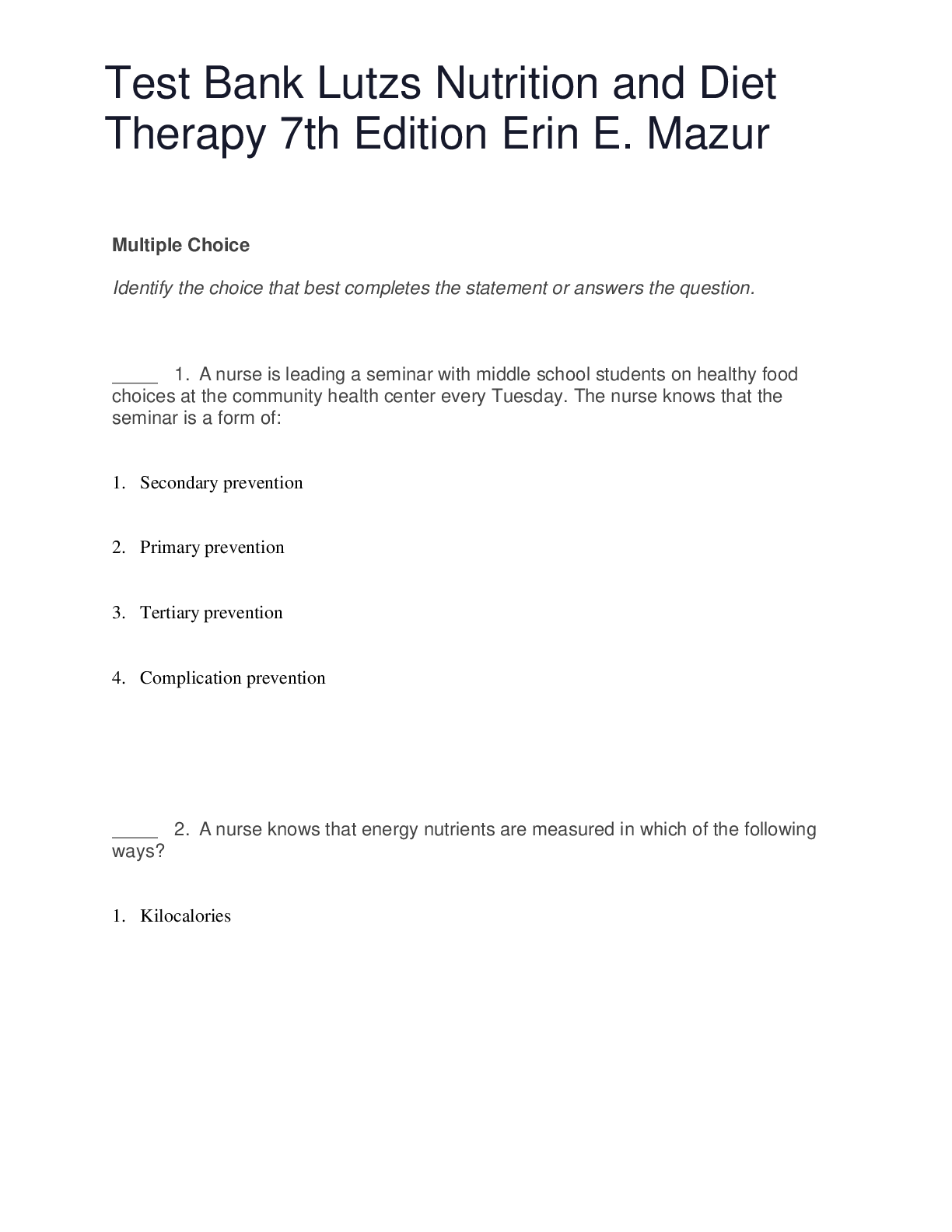
Reviews( 0 )
Document information
Connected school, study & course
About the document
Uploaded On
May 15, 2021
Number of pages
46
Written in
Additional information
This document has been written for:
Uploaded
May 15, 2021
Downloads
0
Views
48

